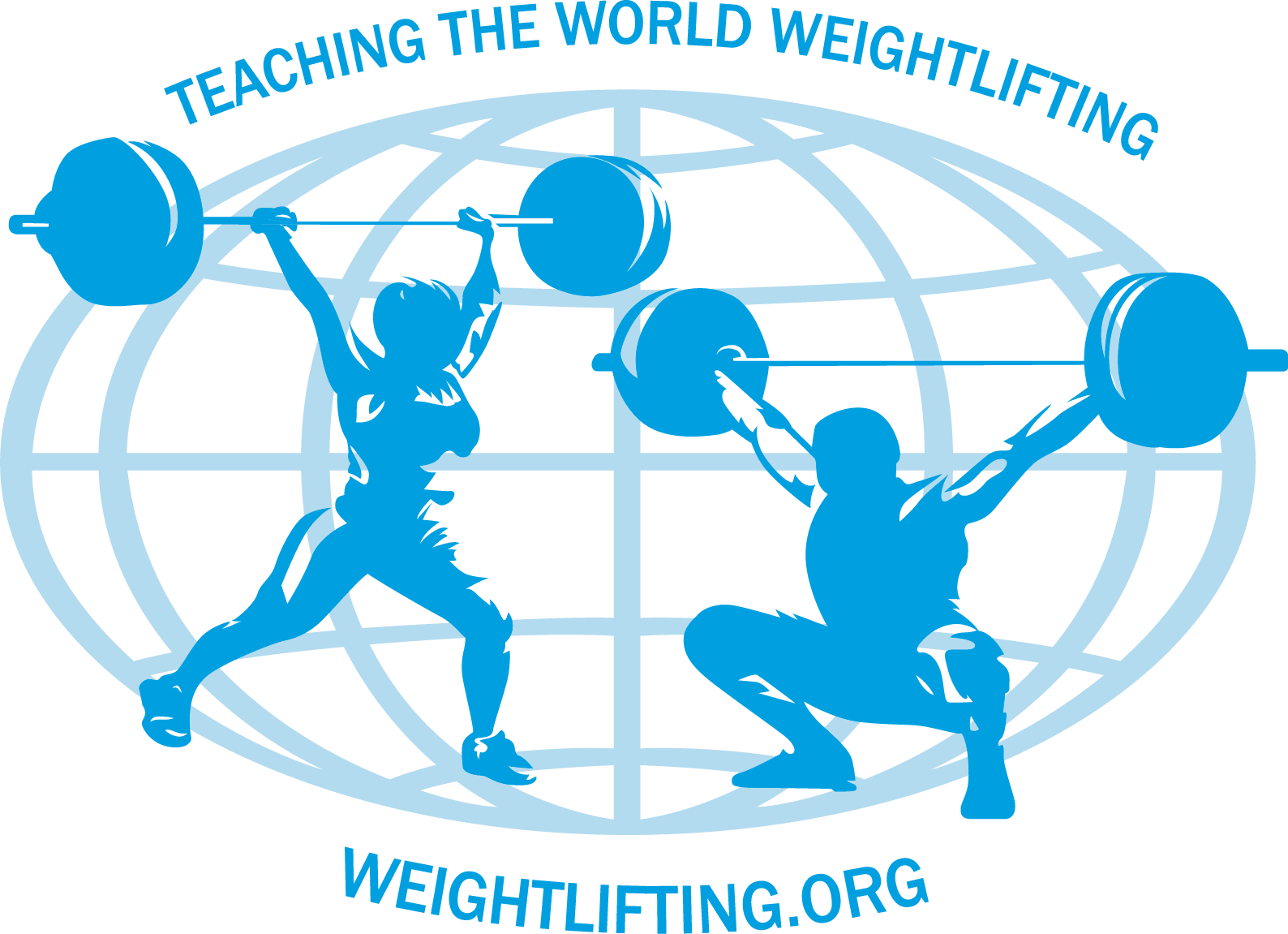
The Association of Oldtime Barbell & Strongmen
The AOBS was founded by Vic Boff and several associates around 1983. It began with holding a birthday celebration for Strongman and Bodybuilding legend, gym owner and writer, Sig Klein. When word the first party got around, many in the Iron Game expressed an interest in attending the next such celebration, leading the size of the gatherings to grow exponentially over the next couple of years. It was at this point that Vic his associates conceived of having and annual gathering “Iron Gamers” to celebrate luminaries in the field. Soon hundreds were attending these events each year.
These events continued under Vic’s leadership, until his passing in 2002. At this point, Vic’s widow, Elaine, asked Artie Drechsler to take over the leadership of the AOBS, which Artie has done to date. However, in taking on the leadership of the AOBS, Artie wanted to broaden the work of the organization while continuing its legacy of preserving Iron Game history. This new organization would carry on Vic’s battle against drug use in the Iron Game, as well as advance the sport of Olympic-style Weightlifting. As a result, Weightlifting.org, Inc. was founded, carrying on this broader work until today.
Declining attendance at the annual AOBS gatherings brought an end to them after the 35th gathering it 2018. However, the newsletter which Vic Boff inaugurated shortly after the organization’s annual gatherings began, continues to this day. It is published quarterly via a PDF format and contains 16 pages or history and some current events in each issue. Click here to see an example of that newsletter, which is provided to all donors to our organization.
Our organization deeply supports remembering the history of Weightlifting and related activities. Currently, we actively support history in several major ways:
• A quarterly 16 page AOBS Newsletter (learn more about the AOBS here)
• Preservation of records of National Weightlifting Championships (see our database here)
• Preservation of the history of American Records in Weightlifting (see our current database here)
Please enjoy our trip into history!
About the AOBS
The Association of Oldetime Barbell & Strongmen, known widely as the AOBS, began with a modest idea – the notion of a birthday celebration for Sigmund Klein. Sig was a major figure in the Iron Game in the US and particularly in the NY area. Klein’s family emigrated to the US in 1903, when Sig was a year old. By the time he was a young teenager, he was exercising on a regular basis. Sig had developed extraordinary strength and a fine physique by the age of 22, when he moved from Cleveland to NY, to work with the legendary Professor Louis Attila.
Sadly, not long after Klein’s arrival in NY, Attila died and his gym was closed. A short time later, Sig reopened Attila’s studio. He later opened a gym under his own name in mid-town Manhattan, which he operated for nearly 50 years.
Because Klein was an accomplished strongman, poser and muscle control artist, anyone who was interested in any aspect of the Iron Game just had to seek out Sig’s appraisal and adivce if he/she passed through NYC, including AOBS founder Vic Boff.
On the occasion of Sig’s 80th birthday, Vic, Leo Murdock and several others decided to hold a surprise party in Sig’s honor. This celebration was held on March 27, 1982. The location was the well-known restaurant – Lenny’s Clam bar in Queens, NY (still operating). The turnout for the event was larger than expected and included such notables as John Grimek and Marvin Eder. The success of the event got Vic and Leo thinking about something bigger and more permanent.
After much thought, a second dinner was organized on November 3, 1984, under the banner the “Olde Time Barbell and Strongman Association”. This name later evolved into the current (AOBS) name of the organization. The gathering was held at Wally and Joseph’s Restaurant in mid-town Manhattan. It was limited to 50 people and sold out quickly. The gathering was so enthusiastic, as was the response to the concept of an actual organization devoted to the recognition of old time champions and Iron Game history, that a third dinner was quickly scheduled, for April 27th of 1985.
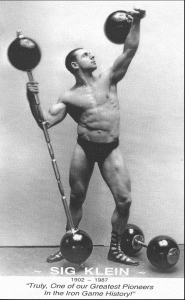
The turnout for this gathering was by far the largest of the three events that had been held to date, and the excitement over the new organization convinced the founders of three things. First, that the demand for such an organization was enormous. Second, that the purpose of recognizing a series of greats over time was extremely appealing. Third, that they would need a bigger place for their future gatherings. Arrangements were made through the contacts of the founders with Rudy Riska, then the Athletic Director of the renowned Downtown Athletic Club, to hold the next event at that location (home of the legendary Heisman Trophy).
It was agreed that the first recipient of the organization’s Highest Achievement Award would be the immortal John Grimek. Widely acknowledged as the greatest physique star of his era, Grimek had also been an Olympian in Weightlifting and a writer and editor for magazines published by the then leading barbell company in the world – York Barbell. Literally hundreds showed up at the Downtown Athletic Club on May 10, 1986, to honor the great Grimek and to show their support for the organization.
Vic and his colleagues knew that evening that they have begun something great, something that should and would endure. The following year, the final elements of the organization began to take shape. There were 3 honorees: Bert Goodrich, Milo Steinborn and Johnny Mandel. While John Grimek represented an unique Renaissance man, Vic and the others felt it would be important to honor people in different realms of the Iron Game, balancing the contributions of several honorees in different disciplines going forward.
In another brilliant stroke, Vic arranged for several strength performers to appear at this dinner, something that was to become one of the event’s most popular features. It also happened that renowned artist, Jim Sanders, whose paintings have appeared in such famous settings as the White House, expressed an interest in presenting to the honorees a painting of them in their prime (he had already done so for John Grimek). At the same time, Iron Mike D’Angelo offered to take still photographs and video footage of the event. These features of the event made for a truly unforgettable evening for the honorees. Imagine being recognized by hundreds of your peers, hearing a brilliant summary of your accomplishments presented by an accomplished speaker, receiving an enormous plaque commemorating your accomplishments, receiving a painting of you in your prime and then having a video that captured the entire evening! Perhaps that is the reason why being honored by the AOBS has become coveted by so many in the Iron Game.
Beginning in 1988, the reunion was moved from the Spring to the Fall, where it continued uninterrupted through the year 2000. However, in 2000, another major change took place, with the event being moved to the Saddle Brook NJ Marriott Hotel, from the Downtown AC. The DAC had been a popular venue that included the fabulous downtown NYC location and the prestige of the Heisman or similar rooms for the banquet. It had offered another major advantage as well, weekend rooms at the DAC that were available in the $50 to $60 per night range. But when the DAC rooms became condos, the only option for out-of-towners was to stay in a downtown hotel at perhaps $200 per night! Instead, Vic was able to secure an arrangement at the Marriott hotel in Saddle Brook, NJ that provided banquet facilities and rooms at reasonable rates (although the central location that the Downtown AC offered was given up).
The Saddle Brook folks did a great job hosting their first reunion in 2000 and the next event was immediately planned there for October 6, 2001. The tragic events of September 11, 2001 resulted in the postponement of the 2001 reunion to June of 2002. And it has remained in that time slot since then. Upon Vic Boff’s tragic and untimely passing in November of 2002, Artie Drechsler was asked to guide the organization, and the first reunion under his leadership took place in June of 2003.
Upon taking on the leadership of the AOBS, Artie wanted to broaden the work of the organization while continuing its legacy of preserving Iron Game history. This new organization would carry on Vic’s battle against drug use in the Iron Game, as well as advance the sport of Olympic-style Weightlifting. As a result, Weightlifting.org, Inc. was founded, carrying on this broader work until today.
The AOBS continued to grow, and in 2008 the location of reunion dinner was moved once again, to a larger facility – the Newark Airport Marriott Hotel. The Newark Marriott is a larger facility than the Saddle Brook Marriott, and is in a more convenient location for those who are flying in for the event. In 2008, the format of the event that was established in 1987 was been modified to specially celebrate the organization’s 25th reunion. Instead of recognizing 2 to 4 new honorees, all previous honorees who were still living (Clyde Emrich’s brilliant idea) were invited to an encore celebration of their achievements. The majority of them attended and the organization had its largest gathering ever – well in excess of 300 people. In 2009, and in each year since, the old format returned, with new honorees each year.
As the years passed, attendance at the annual event began to decline, as many long standing members passed away or became unable to travel. By 2018 attendance at the annual AOBS gathering was less than 50% of what it had been in 2008 and the event had become financially unfeasible. So that year marked the end to the annual event in that format.
However, the newsletter which Vic Boff inaugurated shortly after the organization’s annual gatherings began, continues to this day. It is published quarterly via a PDF format and contains 16 pages or history and some current events in each issue. Click here to see an example of that newsletter, which is provided to all donors to our organization.
AOBS News
Our AOBS Newsletter
Four times per year we publish our AOBS Newsletter. Typically16 pages in length, this newsletter covers the history of the Iron Game along with some current events. All those who donate at least $25 per year to the AOBS receive a PDF copy of this newsletter via the mail. . For a sample of our newsletter, please click here.
AOBS Honorees
The AOBS has honored those who have achieved distinction in the Iron Game with four categories of awards:
• AOBS Vic Boff Highest Achievement
• AOBS Hall of Fame
• AOBS Special Guest
• AOBS Carry On and Great Communicators
All of those who have received these prestigious awards since the organization’s inception are listed on this page, and their grand achievements are memorialized in separate pages devoted to these respective categories.
AOBS Highest Achievement Vic Boff Award Recipients
From its outset, one of the missions of the AOBS has been to recognize and remember the (sometimes forgotten by many) greats of Iron Game history. Hence the founders of the organization created an award which they named their “AOBS Highest Achievement Award” (renamed the “AOBS Vic Boff Highest Achievement Award” in 2003, in honor of founder Vic Boff’s enormous contribution to the organization). In that same year, Vic Boff received the award, posthumously.
The chronology of the Highest Achievement Awards is presented below. It should be remembered that the first 3 dinners, held between 1982 and 1985, were events to honor Sig Klein – one of the most noteworthy contributors to the Iron Game in its long history.
May 10, 1986
John Grimek
(received our Association’s First Highest Achievement Award)
May 23, 1987
Bert Goodrich
Milo Steinborn
Johnny Mandel
Oct. 1, 1988
Steve Reeves
Peary & Mabel Rader
Oct. 7, 1989
Pete George
Marvin Eder
Ed Jubinville
Jules Bacon
Sep. 22, 1990
Tommy Kono
Reg Park
Frank Stranahan
Rudy Sablo
Sep 28, 1991
George Eiferman
Gene Jantzen
Pudgy Stockton
Feb 29, 1992
Paul Anderson
(at the US. Power & Strength Symposium, Orlando, Florida)
Sep 26, 1992
Dr. Jan Todd
Dr. Terry Todd
Ike Berger
Oct. 23, 1993
Terry Robinson
David Webster
Charles Vinci
Oct 8, 1994
Bill Pearl
Dave Sheppard
Leo Stern
Oct 7, 1995
Joe Abbenda
AI Berger
Dr. Hy Schaeffer
Oct. 5, 1996
Norb Schemansky
George Paine
Malcolm Whyatt
Sep 27, 1997
Dave Mayor
Frank Spellman
Bill Clark
Oct 17, 1998
Joe Pitman
Ron Lacy
Slim “The Hammerman” Farman
Oct 23, 1999
Jim Bradford
Harry Johnson
Oct 14, 2000
Bruno Sammartino
Joe Dube
Jim Murray
Oct 6, 2001/ (postponed to Jun 2002)
Al Oerter
Joe Puleo
Kenny Hall
Jun 28, 2003
Vic Boff
Clarence Bass
Clyde Emrich
Jun 12, 2004
Doris Barrilleaux
Gary Cleveland
Dr. James George
Elmo Santiago
Jun 11, 2005
Pat Casey
Red Lerille
Don Reinhoudt
Jun 3, 2006
Russ Knipp
Dick “Smitty” Smith
Dennis Tinerino
Jun 9, 2007
Dave Draper
Mike Karchut
June 7, 2008
All of our previous honorees who were invited back for an encore, to commemorate our 25th Reunion – no new honorees were named.
June 13, 2009
Carla Dunlap
Bill Seno
Bruce Wilhelm
October 23, 2010
Fred Lowe
Dennis Rogers
Chet Yorton
September 17, 2011
Frank Capsouras
Bob Gajda
October 13th, 2012
Lee James
Jon Kolb
October 5th, 2013
Mike Katz
Ken Patera
October 11th, 2014
Anibal Lopez
Karyn Marshall
October 17th, 2015
Gary Deal
John Decola
October 29, 2016
Gayle Hatch
Evander Holyfield
October 21, 2017
Rink Babka
Bob Gallucci
October 20, 2018
Chris Dickerson
Judy Glenney
Many of the greats of Iron Game History were no longer living when the AOBS was founded. In recognition of this, the organization created a posthumous Hall of Fame, to recognize the achievements of those immortals. The first recipient of this award was the many recognized by many as the “Father of American Weightlifting”, and certainly one of the prime movers in the sport worldwide.
June 11, 2005
Bob Hoffman
June 3, 2006
Joe Greenstein “The Mighty Atom”
June 9, 2007
John Henry Davis
October 23, 2010
Warren Lincoln Travis
Joe “The Great” Rollino
September 17, 2011
Eugen Sandow
From time to time, the AOBS presents special awards to recognize outstanding achievement in, and outstanding contributions to, the Iron Game. The following people have been so recognized by the AOBS as “Special Guest Honor Award” winners.
October 1, 1988
Rudy Riska
September 22, 1990
Joe “The Great” Rollino
Dr. Theodore Struhl
September 28, 1991
Leo Murdock
Jim Sanders
October 10, 1993
Dennis Rogers
June 12, 2004
Artie Ehman
October 23, 2010
Dave Prowse
Carry On and Great Communicators
Vic Boff nearly always closed his conversations with this friends with the phrase “carry on”, which signified the dedication of Vic and the person he was speaking with to carry on the traditions of physical culture. Others in the organization used this phrase as well, including AOBS co-founder, Leo Murdock. In 1998, after Leo’s passing, his daughter, Rosemary Miller, conceived the idea of recognizing people who had loyally served the AOBS for many years with a “carry on” award. At the October 1998 meeting of the AOBS, Rosemary recognized three such people. And this tradition has itself been carried on periodically in the ensuing years.
In addition to the “carry on” award, The AOBS has also created special means to recognize those who have been Great Communicators on behalf of the organization with their contributions of oratory and writing.
Oct 17, 1998
Jim Sanders
Mike D’Angelo
Steve Sadicario
Jun 26, 2003
Ann Boff
Joe Marino
June 9, 2007
Artie Drechsler
June 13, 2009
JoAnne Drechsler
Greate Communicators
Dr. Ken Rosa
Fred Yale
AOBS Highest Achievement (Vic Boff) Award Recipients In Alphabetical Order:
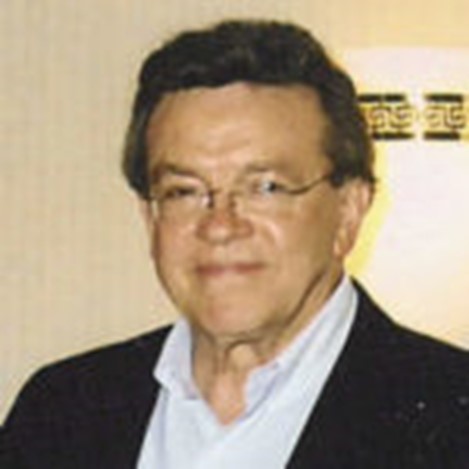
Joe Abbenda emerged on the bodybuilding scene in the late 1950’s. He competed as a weightlifter as well as a bodybuilder, but the latter sport was his focus from day one. After years of hard work on simple exercises, Joe’s training paid off in a very big way, when he won the Teenage Mr. America competition in 1959. In 1960, he placed 5 the Mr. America competition, moving up to 2nd place in 1961. The following year proved to be the breakout year for Joe, as he won both the 1962 Mr. America and amateur NABBA Mr. Universe titles. In1963, he returned to the NABBA Mr. Universe competition, this time as a professional. He continued his undefeated streak in taking the 1963 professional title. Shortly thereafter, Joe enhanced his worldwide reputation when he traveled to South Africa to appear with Reg Park in a series of exhibitions. Joe went on to become an educator for many years, coaching young men and women with regard to the benefits of exercise, particularly weight training. He then earned a law degree and today is in private practice as an attorney.

Paul Anderson is a World and Olympic Champion in Weightlifting. Paul burst upon the strength scene in late 1952, and in a little more than a year was rewriting the record books in weightlifting, while almost single-handedly establishing the squat as the primary assistance exercise for weightlifters from that point forward (as well as helping to firmly establish the squat style of lifting as the dominant style thereafter). Known for squatting weights that were previously unheard of, he was probably the first man to squat 300 kg., 400 kg. and 500 kg. If there was a single athlete in the 20th century who earned the right to call himself the undisputed world’s strongest man, it was Paul Anderson. The Russians called him a wonder of nature and indeed he was.
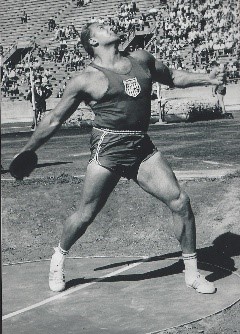
Richard “Rink” Babka is a true legend in the world of Track & Field. A former world record holder in the discus throw, he was the first man to throw the disc over 200 ft. in official competition. Across his long career Rink won a silver medal at the 1956 Olympics and at the 1967 Pan American Games. On a national he won both the NCAA and AAU national titles. An outstanding athlete in multiple sports, Rink was signed to play with the San Francisco 49ers, although he never played in a season game. He is also recognized for his outstanding sportsmanship, which included helping an opponent to beat him at the Olympic Games! You’ll hear more about this in October!

Jules Bacon – Mr. America in 1947, Jules Bacon was considered to have one of the most symmetrical and aesthetically pleasing physiques of his era and beyond. Jules was a key player in the formative years of the York Barbell Co. Jules also played a key role in the popularization of food supplements, when he gave Bob Hoffman samples of a unique protein supplement that Irwin Johnson had developed. Bob tried the protein powder and pronounced it “the” new thing. It became the greatest financial success in the York Barbell company’s history and one of the earliest successes in what was to become the huge food supplement industry.
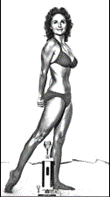
Doris Barrilleaux – A true pioneer in women’s bodybuilding, Doris has often been referred to as “The First Lady of Bodybuilding.” An outstanding competitor in her own right she, perhaps more than any other person in the history of the Iron Game, made national and international women’s physique competition a reality. Even while she was competing, she devoted her endless energy in organizing and promoting women’s bodybuilding competitions, wherever and whenever she could, eventually in virtually every state of the union. Moreover, despite having invested so much of her life’s energy in getting women’s bodybuilding under way, Doris had the courage to take a stand against the drugs she believed would ruin the sport she had worked so hard to build. She walked away from a coveted leadership position with a major bodybuilding organization as a protest of the movement of drugs into the world of women’s bodybuilding. However, she did continue her career as one of bodybuilding’s top photographers and is donating her massive collection of women’s bodybuilding memorabilia to the Todd-McLean Library.

Clarence Bass – After a fine career in weightlifting, Clarence moved into the field of bodybuilding with a vengeance. In “Past-40” bodybuilding competition, he has won his height class in both the Mr.America and Mr. USA competitions. In the latter competition, he has also earned the Most Muscular, Best Abs and Best Legs awards. But Clarence is probably best known for the instruction and inspiration he provides to others. It all began with his now classic book “Ripped”. Espousing the benefits of a healthy diet and proper exercise, Clarence is living proof that this philosophy works. After his initial book, Clarence has gone on to produce a series of books and videos that have literally reached many thousands around the world with his prescription for healthy living and with a lean and muscular physique.As the photos of now 70-year-old Clarence in his latest book (“Great Expectations”) show, Clarence remains in phenomenal shape to this day. Given his example and his prolific communications, his audience will no doubt continue to grow.
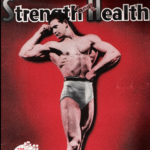
Al Berger – A Strength & Health coverman in May of 1941, Al Berger was renowned for his physique and strength feats. He was particularly well known for his gripping and forearm strength. His signature feats consisted of performing chins hanging from rafters that he pinch-gripped while performing the chins. Al was able to perform 12 consecutive chins in this manner, and a single rep with 43 lb. of added weight. He also performed a strict reverse curl with 165 lb., further demonstrating his arm and grip strength.
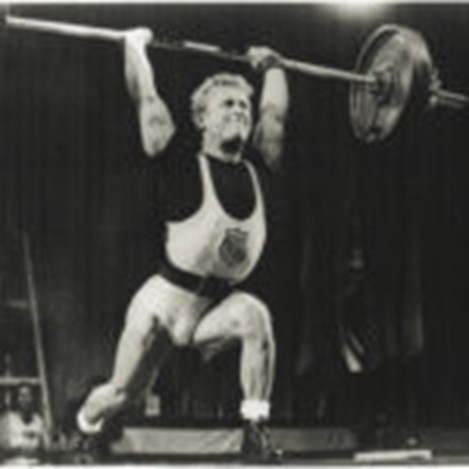
Isaac Berger had one of the fastest rises in weightlifting history. After entering his first weightlifting competition in 1952, Berger improved so fast that by 1955 he became a National Champion. Defending his title in 1956, despite an injury, Berger lifted enough at the 1956 Olympic Trials to earn a berth on the team going to Melbourne. He moved his training into high gear and shocked the weightlifting world by winning the Olympic Games as a teenager and breaking the world record in the total at the same time. He later went on to win both the 1958 and the1962 World Championships, along with silver medals in both the 1960 and 1964 Olympic Games. Isaac also set many world records across his illustrious career. The last world record he earned, at the Olympic Games in Tokyo, in 1964, was a 152.5 kg. C&J. That record lasted for more than 5 years, becoming one of the longest held world records in weightlifting history.
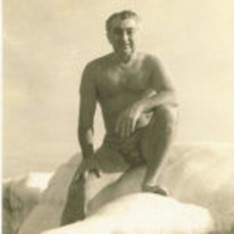
Vic Boff – Long before becoming one of the founders of the AOBS, Vic Boff had established his reputation in the Iron Game. In his early years, he was a professional level boxer and baseball player. He became deeply involved in the areas of diet and exercise. A meeting with George Jowett led Vic to a lifelong commitment to the Iron Game. Early in life, Vic noticed that he loved the cold weather that others shunned. He eventually became the long-term President of the Iceberg Club – a club dedicated to year-round ocean bathing from its home base in Coney Island. In the 1960’s Vic opened the first of several health food stores that he would own. His Brooklyn store soon became his flagship and it attracted Iron Game notables from virtually everywhere. Vic was a well-known writer in the fitness field and a confidant of Bob Hoffman and countless others in the fitness world. Vic seemed to know everyone in and everything about the Iron Game. So it was natural for him to become the leader of the AOBS – an entity that Vic dedicated 20 years of his life to building. We all owe him the deepest debt of gratitude for his great work.
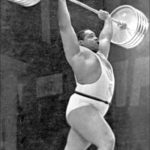
Jim Bradford – Jim has always considered himself a strongman, more than a weightlifter. He prided himself in being able to compete with the best weightlifters in the world with limited technique and one of the strictest pressing forms of any athlete in the world at the time. Across his career, Jim won 2 US National Championships and earned silver medals at 4 World Championships, and in both the 1952 and 1960 Olympic Games. In the latter case, he gave the USSR’s legendary Yuri Vlasov a run for his money. In addition to being remembered for the lifting he did do, Jim is famous for the lifting he declined to do. Competing at the World Championships in Milan, in 1951, Jim battled it out with the legendary John Davis, who was defending his undefeated record at World and Olympic Games that began in 1938. When Davis was injured during the competition, Bradford refused to take his last C&J attempt, not wanting to defeat an injured man, or force Davis to take another lift, which might have injured John further. Bradford’s act has gone down as one of the greatest displays of sportsmanship in the history of sport.
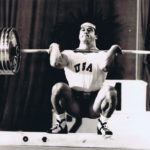
Frank Capsouras – Frank made a sudden impression on the national weightlifting scene when, at the age of 17, he made a 354 lb. C&J to place second at the 1964 Olympic Trials in the 82.5 kg. bodyweight category, and to establish a Teenage American record in that lift. He then went on the win three Teenage National Championships in a row. Frank continued to improve over the next several years and moved his bodyweight up to 90 kg. He made a World Record in the C&J in April of 1969, when he lifted 199 kg. He then went on to win his first Senior Nationals later that year, and to place sixth in the World Championships. Moving his bodyweight up once more over the next several years, he won his second Senior National Championships in 1972 and earned a spot on the US Olympic Team that he had tried so hard to make in 1964 and 1968. Frank placed 10th at the Olympic Games. He earned a bronze medal, overall, at the 1975 Pan American Games and retired in 1977.
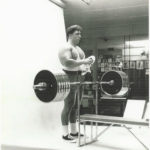
Pat Casey – Early in his weight training career, Pat Casey became enamored with pressing exercises and getting big. His favorite exercise was the bench press, and while others were looking at 500 lb. as being somewhere near the ultimate lift, Pat announced that he would bench press 600 lb. While many doubted such a lift would ever be made, Pat trained relentlessly to reach the objective he had promised to the world. He accomplished his long sought after goal on March 25, 1967, when he officially bench pressed 615.5 lb. However, in addition to becoming perhaps the best-known bench presser in the world at the time, Pat developed into an exceptional all around lifter, becoming the first powerlifter to total 2000 lb. officially.
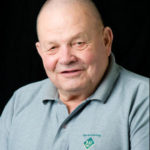
Bill Clark – In 1959, when some boxers he was training wanted to enter the Missouri State Weightlifting championships, Bill found there was no such event, so he decided to run it. The following year he became the chairman of his local AAU weightlifting committee, a position he retained for approximately 30 years. In 1962, Bill organized postal competitions in the US prison system, a program that lasted more than 20 years and produced some of the top lifters in the country. By 1964, Bill cooperated with Jim Witt and Homer Brannum to persuade the AAU to permit the organization of the first National powerlifting championship. In 1973, Clark was innovating again, asking the AAU to permit him to run the first National Masters weightlifting competition, which was held by Bill in 1975. Today more than 60 nations compete in Masters Weightlifting competitions worldwide. In 1986, Bill worked with Tony Cook of England to form the International All-Around Weightlifting Federation, which continues its activities today. Without innovators like Bill Clark, the Iron Game would not be nearly as rich and diverse as it is today.
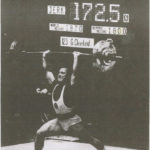
Gary Cleveland – Newer members of the Iron Game may remember Gary Cleveland for the newsletter, the “Avian Movement Advocate”, a mixture of Iron Game history, serious weightlifting analysis and pure whimsy. But Gary was, for a number of years, one of the top weightlifters in the World. Gary made his international debut at the 1962 World Championships, where he took 5th place – outstanding for such a young athlete in his first World Championship. He placed 5th at the Worlds in 1963 and repeated that placing at the Tokyo Olympic Games. In March of 1965, he made more weightlifting history by breaking the long-standing light heavyweight American total record held by Tommy Kono, by lifting a total of 1015 lb.
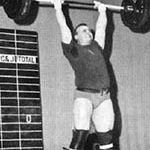
Gary Deal – After being stricken with polio at the age of 10, Gary worked very hard to return to some sense of normal functioning. It wasn’t until we discovered weightlifting, at the age of 16, at a bodyweight of 150 lbs. that he began to build his body to herculean strength and size. By the time he was 18 he won the Teenage Nationals. But he did win another National Title until 1969, when he became the Junior National champions and placed second in the National, with an incredible 30 lb. personal record in his last lift, which won him a spot on the World Championship team. The following year he placed 2nd in the Nationals again and earned another spot on the World Team, very nearly winning a medal for the US. In 1971, he finally won the Senior Nationals and went on to win the Pan American Games.
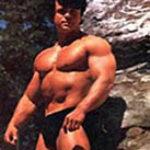
John Decola – One of the most popular bodybuilders of the 1960s, and dedicated to the natural development of his physique, John graced the cover of both Strength and Health Magazine and Muscular Development magazines on multiple occasions. Strong as well as herculean is appearance, after considerable success in AAU bodybuilding, culminating by his win at the 1964 Jr. Mr. America competition, John moved to the IFBB in the late 1960s. He was crowned the IFBB Mr. America in 1969, against some tremendous competition. John has remained active in the fitness work ever since he retired from competition, and remains in terrific condition to this day.
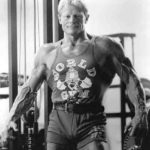
Dave Draper – Known during the 1960s as “America’s Strongest Youth” and the “Blond Bomber”, Dave Draper became an idol to the teens who followed the sport of bodybuilding in that era. With a physique possessing a combination of extraordinary size and balance, Dave was soon winning major titles with regularity. He subsequently reformed his physique, becoming known for his extraordinary definition. As Dave continued the training that he loved in his later years, he began to realize that many in the Iron Game were inspired by his tenacious dedication to training and his unique style of writing about his personal experiences with training. Today, he operates one of the most successful websites on bodybuilding in the world and is in great demand as a speaker, both for the motivation his communications impart and for the wisdom regarding training they contain. Such wisdom could only be gathered by someone who has been as dedicated and consistent in his training as Dave has been for so many years.

Chris Dickerson is one of the true greats in bodybuilding history. On the competitive level, he is the only man in bodybuilding history to win highest bodybuilding titles in all four major bodybuilding organizations: Mr. America (AAU), Mr. Universe (NABBA), Pro Mr. America (WBBG), and Mr. Olympia and Masters Olympia (IFBB). But he was also a pathbreaker on multiple levels. He was the first black AAU Mr. America (in 1970). He was the oldest man ever to win the Mr. Olympia title (at age 43), demonstrating not only his outstanding physique, but his outstanding longevity as well. He later went on to win the Masters Olympia, one of only two men ever to have won both the Open and Masters Mr. Olympia divisions. And on an artistic level, the photos he made with some of the most artistic physique photographers in history broke new ground in that. Chris was truly a bodybuilder’s bodybuilder.
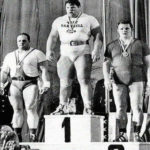
Joe Dube – Joe first burst upon the weightlifting scene as a teenager, becoming the first teenager in history to press 400 pounds. In his twenties, he continued to gain bodyweight and strength, rising to become a top contender for the superheavyweight championship of the US, and one of the best lifters in the world. During his illustrious career, Joe set numerous American and World records. He won the Pan American Games in 1967 and went on the following year to win a bronze medal at the 1968 Olympic Games in Mexico City, the only American to medal that year. Inspired by his Olympic experience and convinced he could defeat the reigning superheavyweight Olympic and World Champion, Leonid Zhabotinsky (who said the Americans could never beat him), Joe trained with a vengeance for the 1969 World Championships. His dedication was rewarded when he handed Zhabotinsky his first defeat since he the Russian won the Olympic Games in 1964. With his victory, Joe became the last American male to date to win a world weightlifting championship.
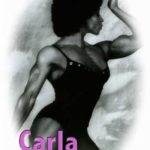
Carla Dunlap – Carla Dunlap’s athletic career began with gymnastics and swimming (she was part of the team that won the 1977 Jr. National championships in synchronized swimming). In 1979, she placed 5th in the “Best in the World” physique competition, having never trained specifically in bodybuilding. She decided to train seriously in 1980, and in that same year she won the AAU Ms. America competition. In 1981 she won the NPC Nationals, repeating in 1982. That same year she entered the Ms. Olympia competition, placing second. Later that year, she won the Pro World Championships. Carla won the Ms. Olympia competition in 1983, along with the Caesar’s World Cup (Grand Prix Las Vegas). In 1984 she won the World Professional Mixed Pairs title with Tony Pearson (they repeated their win in 1988). She then went on to star in the documentary films “Women of Iron” and “Pumping Iron II – The Women”, which helped to break the barriers between women and iron. She promoted women’s bodybuilding on such shows as Good Morning America and Regis Philbin, was a regular cast member in “Body Shaping” and served as a commentator for ESPN.
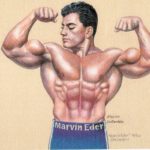
Marvin Eder – Marvin was considered one of the most amazing physique and strength stars of his era. Known initially for his physique, he earned 3 rd place at the Mr. America competition at the tender age of 19. Such a physique on a person so young was considered virtually impossible heretofore. But as information on Marvin’s training methods reached the public, it was the strength and endurance he exhibited during his workouts that became even more legendary than his physique. He bench pressed more than 500 lb. while weighing under 200 lb. and could perform repetitions in the press with the then world record in that movement. Perhaps his most amazing accomplishment was a dip with 434lb. of added weight – a feat that has never been approached by anyone of any bodyweight since Marvin.
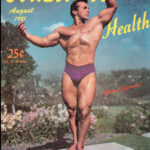
George Eiferman – George was one of bodybuilding’s best-known champions. He won the Mr. America title in 1948. Amazingly, he came back to win the Mr. Universe title 14 years later, in 1962. A man of many talents and trades, George performed with Mae West for a number of years. He appeared in a movie “The Devil’s Sleep”, in 1955. Later in life, George had a string of health clubs in Las Vegas where the stars, visitors, and locals came to get or stay in shape.
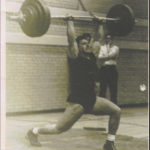
Clyde Emrich – Clyde is remembered by many as an Olympian, a 4-time National Weightlifting Champion, a medalist in 2 World Weightlifting Championships and a World Record Holder in weightlifting. But after his weightlifting career was over, Clyde, went on to make another great contribution to the Iron Game and to the spread of the use of weight training in sport. After providing free weightlifting instruction to some of the most well-known players on the legendary Chicago Bears football team, Clyde was hired by the Bears to become one of the pioneers of the Strength Coaching field. He started officially working the team in the in the 1960’s. Although he has gone on to accept broader duties within the organization, Clyde continues to help out in the weight room. In the fickle and stressful world of professional sports, a stay of that length with one team speaks for itself, as does Clyde’s Super Bowl ring and the training facility the Bears have recently dedicated in Clyde’s name.
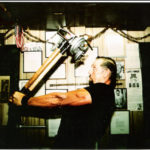
Slim Farman – Slim “The Hammerman” Farman worked as a stone cutter most of his life. Unlike many in that field, he did not regard that profession solely as a form of skilled labor, but also as a profound challenge to his physical strength and skill. Wielding his sledge hammers on a daily basis had given Slim extraordinary strength in his hands, wrists and arms, but it was a chance meeting with the legendary “Mighty Atom” – Joe Greenstein – that propelled Slim into a career as a professional strongman and an heir to the Atom. Apprenticing under the Atom, Slim soon learned and developed his strength sufficiently to duplicate many of the Atom’s amazing feats, but he coupled those feats with hammer lifting feats of his own design, welcoming others to try and duplicate what he could do (which no one ever has). A phenomenal showman, as well as strongman, Slim has thrilled audiences all over the country with his feats of strength and his incredibly polished way of presenting them. Slim has carried on the legacy of the Atom in another important way, by inspiring a new generation of strongmen to carry on the feats performed by the Atom and to invent new feats of their own.
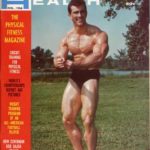
Bob Gajda – Bob took up weight training in HS, in an effort to improve his performance in other sports. His love of training grew over the years, as did his muscles. He began to win local bodybuilding competitions, and by 1965 won the AAU Mr. USA title. The following year, he won the coveted AAU Mr. America title and the FICH Mr. Universe title as well. He also became and accomplished weightlifter. He then went on to establish himself as an author and inventor. By the 1970s, he had begun to focus on training others and soon established one of the most respected sports performance and rehabilitation programs in the country, a program to which he continues to devote himself until today.
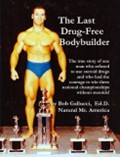
Bob Gallucci was considered one of bodybuilding’s fastest rising and most promising stars in 1966, when he won the AAU Teenage Mr. America competition. But at this point Bob reached a fork in the road. One led to professional success in bodybuilding, with the assistance of anabolic steroids. The other road led to a clean, healthy and drug free life. Bob chose the latter and became one of the first natural Mr. Americas. He went on to a long and distinguished career as an educator, whose dual message of the inestimable value of weight training and the terrible threat of performance enhancing drugs was an enduring theme throughout his career.
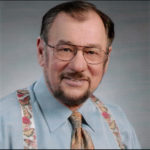
Dr. James George – During his phenomenal weightlifting career, Jim won four National Championships and a Pan American Games. He was a medal winner at four World Championships, won a bronze medal at the 1956 Olympic Games in Melbourne and earned a silver medal at the 1960 Olympic Games in Rome. In addition to winning an Olympic medal in 1956, during the competition, Jim set a world record in the snatch with 303 lb. Only 3 days after he lifted at the Games, he made a world record in the C&J with a lift of 388 lb.
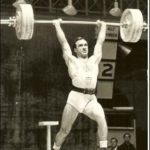
Dr. Peter George – Pete George’s career accomplishments included winning 6 National Championships,an Olympic Games in 1952 (and silver medals in 1948 and 1956), along with 5 World Championships. Pete also established many World Records in his signature squat style and in so doing became a role model for many other athletes interested in lifting in that style. Pete cooperated with his coach Larry Barnholth to publish ‘Secrets of the Squat Snatch” – the first book to explain the advantages and training methods needed to learn to perform the squat snatch. That book and Pete’s lifting inspired many athletes to try and master the squat style of lifting.
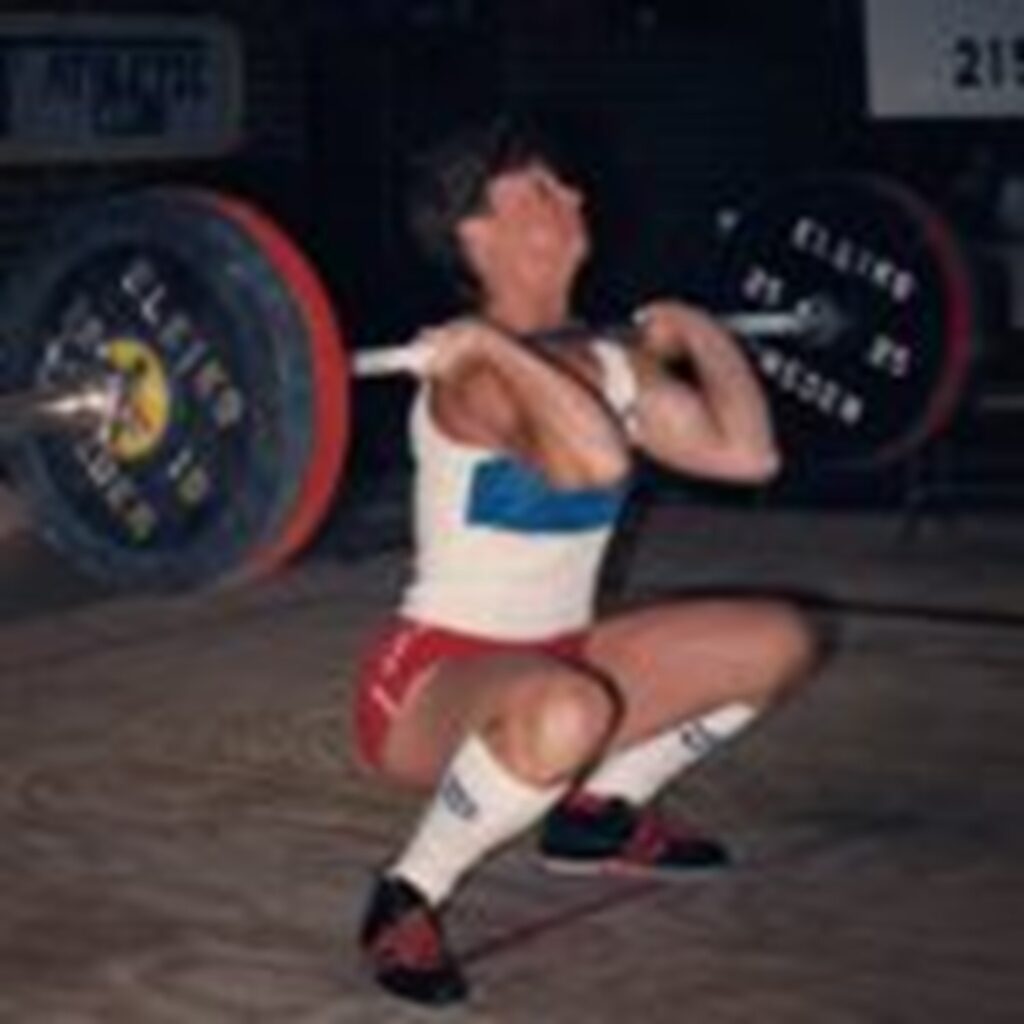
Judy Glenney, coached by her husband Gary (a national championship medalist), began her lifting career by competing unofficially against men. She became involved in the movement to create a national weightlifting championship for women and not only won her (67.5 kg.) bodyweight category at the first Women’s Nationals (in 1981, in Waterloo, Iowa) but she out lifted every other woman in the competition – including the superheavyweights. She went on to win the next three Women’s Nationals in her bodyweight category and set national records. As a Master, she won the 1997 World Master’s Championships and the 1998 World Master’s Games, as well as five Master’s National Championships. Succeeding Mabel Rader, she served as Chair of the USAW’s Women’s Committee from 1983 to 1989, helping to promote the development of women’s lifting in the US and around the world. She served as a referee at both the first Women’s World Championships in 1987 and the first Olympic Games with a women’s competition, in 2000. Widely published, she wrote “So You Want to be a Female Weightlifter?” in 1989.
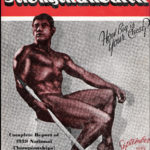
Bert Goodrich – Bert began training in 1928, under the guidance of the renowned trainer and historian, David Willoughby. In 1934, he was prevailed over 54 competitors to win “Best Built Man in NY” title. In 1938, the won the “America’s Best Built Man Competition”, which was later acknowledged as the first official Mr. America competition. He was a cover man for a number of magazines, including Strength & Health. He was also famous for being a Hollywood stunt man, becoming as well known in that field as he was in the bodybuilding arena and protecting such famous stars as John Wayne and Buster Crabbe.
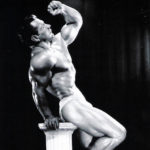
John Grimek– Perhaps no bodybuilder was admired by his peers more than the great John Grimek. His incomparable strength, incomparable physique, posing ability, flexibility and charisma combined to make him arguably the greatest all around Iron Game competitor in history. John first earned fame as a weightlifter, winning the US Nationals in 1936 and earning a spot on the 1936 Olympic Team. But by the late 1930s, he began to focus more on physique development. When he appeared in the 1940 Mr. America competition, his physique was considered the most outstanding by far. When he repeated his Mr. America victory again in 1941, by a wide margin, officials decided that no one would ever beat him, so they declared that no one would be allowed to win the Mr. America title more than once. In 1948 John won the NAABA Mr. Universe competition. He retired undefeated after winning the inaugural Mr. USA competition in 1949, becoming a prolific writer on the Iron Game, and an inspiration to generations of strength athletes, in the US and throughout the world.
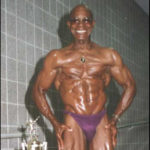
Kenny Hall – Kenny emigrated to the US from his native Barbados having already won the Mr. Barbados title. He became Mr. New York State in 1962. But Hall was not as successful on a national level (placing 10th in the Mr. America competition the same year). Many have argued persuasively that Kenny, along with other physique competitors of color, such as George Paine, Arthur Harris, Elmo Santiago and Harold Poole, never placed as high as they should have because of the prejudices of certain judges. However, Kenny persevered, winning such titles as Mr. Universe over-40 and Pro Mr. America over-50, all while being lifetime drug-free.
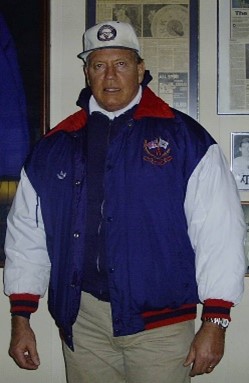
Gayle Hatch – Gayle Hatch, a legendary weightlifting and strength coach, is a giant of a man in physical stature, but even more of a giant in terms of the breadth and depth of his accomplishments. After an outstanding career in collegiate basketball (he was honored as the most accomplished player ever to attend Northwestern State University) Gayle took on the lifelong mission of spreading the word about the value of weightlifting (as a sport and a training modality) and how to do it. Across his storied career he produced many great weightlifters and athletes in other sports, and was the head coach for the men’s 2004 US Olympic Weightlifting Team. But on top of that, he was the leading advocate for the abolition of drug use in the sport of weightlifting in the US – and he got results. Of course then there is the story of how Gayle persuaded General Mills to put Jim Thorpe on the Wheaties box – a story you’ll hear more about at this year’s dinner. Suffice to say that when you learn coach Hatch’s full story, you’ll be astounded.
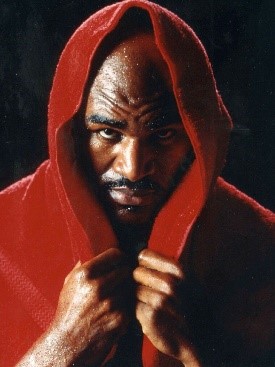
Evander Holyfield scarcely needs an introduction, at least to anyone who follows mainstream sports at all. After winning bronze medal in boxing for the US, at the 1984 Olympic Games, Evander turned professional the following year. By 1986 he’d become the WBA Cruiserweight World Champion and soon unified the title. Then, in 1988, he moved up to the heavyweight division and defeated Buster Douglas to become the heavyweight champion of the world. He would ultimately win the heavyweight title an astounding five times – the most of any heavyweight boxer in history – and he won his last fight when he was in his later forties. Evander credits much of his outstanding success in boxing, and his amazing longevity in the sport, to weight training – an activity that was, and still is, frowned upon by many uninformed boxing trainers. But the evidence Evander amassed may well help to turn the tide in boxing. I’m sure you will all look forward to meeting this great champion and hearing more about his amazing accomplishments at our gala.
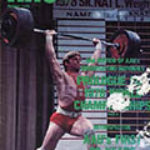
Lee James – When Lee James placed 4th in the light heavyweight (82.5 kg) class at his first Sr. National Championships in 1974, few would have predicted the meteoric rise that was to bring him to international stardom in a period of two years. At the 1975 Nationals Lee placed 2nd, earning spots on that year’s US World Championships and Pan American Games teams. Following those championships, Lee made the bold decision to move up to the middle heavyweight (90 kg.) bodyweight category less than a year before 1976 Olympic Games and his performances surged. In 1976 Lee won his first National Championship. But the best was yet to come. Lee made his best performance to date at the Olympic Games in Montreal, where he won the Silver Medal. After missing most of the 1977 season due to an injury. Lee made an amazing comeback in 1978 to win still another National Championship, set an American Record in the snatch and come close to two more records. But he was injured once again preparing for the 1978 World Championships and he retired shortly thereafter.
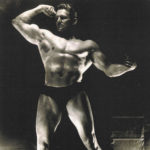
Gene Jantzen – Jantzen’s outstanding physique enabled him to be chosen as the Strength & Health cover man in the June 1941 issue of that magazine (an honor he was to be afforded twice more in his career). Jantzen went on to become the owner and manager of a resort, a corrective therapist, sculptor and published poet. A chance sighting of a mail order exercise course launched Jantzen’s training. In 1944, he placed third in the Mr. America competition and in 1947 won the “Finest Physique in America” title, an award conferred by Bernarr MacFadden’s Physical Culture magazine, one of the leading publications of the day.
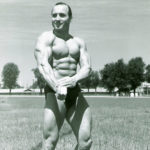
Harry Johnson – Harry was one of the most persistent competitors ever to win the Mr. America title. Harry began bodybuilding during the 1940’s and placed 16th in the 1952 Mr. America competition, after years of training. In 1953 he moved up to 14th place. In 1954 he placed 5th and earned that placing again in 1955. In 1956 he placed 6th in the same competition, although he did win the short division of the Mr. Universe competition that year. In 1957, he moved up to 3rd place at the Mr. A. In 1959, the title he had worked so long and hard to attain became his, when he was named Mr. America. At that time he was the oldest man ever to win that competition. While operating his long-running gym, Harry trained for and won the 1966 Masters Mr. America title.
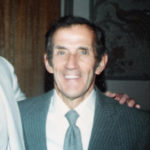
Ed Jubinville – Ed made many contributions to the Iron Game, but he was perhaps most famous for his abilities in the art of muscle control. At a time when muscle control had become a dying art, Ed mastered that skill and thrilled audiences around the world with this physique and ability to control the muscles that made it up. In addition to his performing skills, Ed manufactured some of finest gym equipment of his day. He was also a stalwart meet promoter in the New England area for decades, his shows drawing huge crowds to see displays of many legends of the Iron Game.
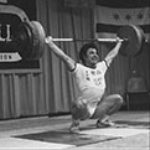
Mike Karchut – One of the most outstanding lifters in the US during the late 1960s and through the 1970’s, Mike Karchut was renowned for his outstanding technique and dedication to the sport of weightlifting. Across a career that spanned more than 25 years, Mike amassed 8 National Championship titles, broke 10 American Records and was a member of 3 US Olympic teams. His international accomplishments included a Gold Medal at the Pan American Games and a total of 4 bronze medals at 3 World Championships. He also has the distinction of competing in more consecutive National Championships in US weightlifting history – 25. Mike was always one of the most popular lifters in the US, not only because of the wonderful style with which he lifted, but for the deep and sincere encouragement he provided to so many lifters of his day and in the years that followed, by his example and by his willingness to help anyone who has a sincere desire to improve his or her weightlifting performance.
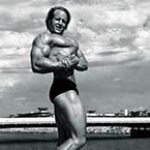
Mike Katz – Katz had a diverse athletic career that led to an unusual dual focus on bodybuilding and football, sports in which he truly excelled. After suffering intense bullying as a youth, he discovered the miracle of weight training, which transformed his size and strength, along with his confidence. He played football while in school and was so outstanding in his accomplishments that he was drafted by the NY Jets, where his promising football career was unfortunately ended by a knee injury.
Mike had an outstanding bodybuilding career, ultimately winning the IFBB Mr. World competition and placing second at the Mr. Olympia. He had a major role in the famous film “Pumping Iron” and soon became one of bodybuilding’s most popular competitors.
Throughout the years in which he pursued his athletic endeavors and beyond, Mike had another career as a teacher for more than 30 years in the Connecticut school system, where he taught young people the benefits of exercise. He expanded his teachings outside the school system when he opened one of the first World Gyms in the US and later Planet Fitness. He was also one of the earliest celebrity participants in the now revered Special Olympics.
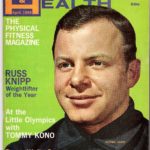
Russ Knipp – Knipp was started in the sport of weightlifting at the tender age of 6, by a father who was a powerful lifter. Knipp made his first major mark on the international weightlifting scene on July 23, 1966, when he pressed a World Record of 152.5 kg (336 lb) at a bodyweight of 165 lb. He went on to make three more World Records in that lift. But Russ was an exceptional all-around lifter as well, having been the first middleweight (165 lb.) US lifter to total 1000 lbs. on the three lifts. Across his outstanding career, Russ won 3 National Championships, a Pan American Games and Gold medals in the press at 2 World Championships.
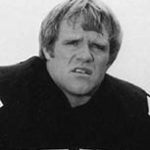
Jon Kolb – Kolb’s football career began at Owasso High School in his home state of Oklahoma. After earning all-state honors, Jon attended OSU, where he started at center and was selected as an All-American1968. He was drafted by the Pittsburgh Steelers in 1969 and by 1971 had earned a position as their starting left tackle, protecting the legendary Terry Bradshaw and helping the Steelers earn four Super Bowl victories. Jon had found weight training critical to his success in football and was widely regarded by many as the strongest man in football at that time. He proved his strength against some of the best when he placed second in the World’s Strongest Man competitions of 1978 and 1979. Jon went on to become the strength and conditioning coach with the Steelers and later put his knowledge of training to work in rehabilitating the sick and injured, which he continues to do as Director of the Wellness Center at Specialty Orthopedics in Hermitage, PA.
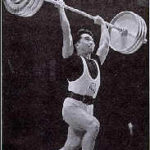
Tommy Kono – If being a sickly and underweight child did not make Tommy Kono’s early years difficult enough, being interred with his family at the Tule Lake detention camp during WWII (for no other reason than their Japanese ancestry) raised the bar. But during his interment, Tommy took up weight training and thereby started one of the greatest careers in world weightlifting history. A winner of 6 World Championships, 2 Olympic Games (winner of a silver medal in a 3 rd), holder of 26 World Records is 4 bodyweight categories, Tommy is on anyone’s short list of the greatest lifters of all time (he has been officially recognized by the International Weightlifting Federation as one of the greatest lifters of all time). As if his record as athlete were not sufficient to preserve his name in weightlifting history, Tommy is perhaps the only coach ever to have coached Olympic Teams from 3 different countries (Germany, Mexico and the US). More recently, he has authored the classic book – “Weightlifting – Olympic-style”.
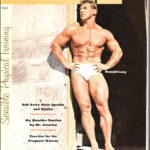
Ron Lacy – During his successful career in college football, under the legendary Bear Bryant, Ron discovered his ability with the weights, when he pressed bodyweight (170 lb.) the first time he tried it. That marked the beginning of his career in weight training. Over the next 7 years, Ron slowly worked his way up to bodybuilding stardom, placing 3 rd in the Mr. California competition in 1954, 10th in the Mr. America contest in 1955, 2nd in 1956 and finally winning the crown in 1957. That same year he won his height division at the NABBA Mr. Universe. After winning his title, Ron continued to train, and to train others, for the rest of his days.
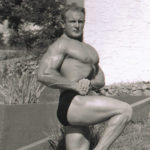
Red Lerille – While he had successfully competed in a number of high-level bodybuilding competitions by the time he entered the Mr. America contest in 1960, Red Lerille was far from the favorite. Nevertheless, he prevailed over more experienced competitors to win that coveted title. Upon returning home, Red immediately set about achieving the second of his boyhood goals (winning the Mr. America competition had been the first). That second goal was to build a gym where people who were seeking health and strength could gather together to build their bodies. Red has succeeded beyond even his own imagination. Through his relentless work over a span of more than 40 years, Red has built the largest health club in the Southeast, and one of the largest in the world. Today that club includes more than 200,000 square feet of fantastic space that accommodates the fitness and recreational desires of countless members of his community. So outstanding have been Red’s achievements that he is recognized as one of the legends of the fitness industry.
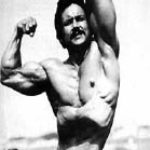
Anibal Lopez – Anibal was always fascinated by strength and power. His childhood heroes were Tarzan and Hercules. His earliest athletic endeavors centered around gymnastics, but after seeing Steve Reeves portray Hercules on the big screen, he fell in love with bodybuilding. His early bodybuilding training was rewarded by a victory in his first competition, Mr. Wagner (named after the youth center in Manhattan). After placing 3rd in the 1973 AAU Mr. America, he won the WBBG Pro Mr. America in 1978 and in 1980 the WBBG Pro Mr. World. Since retiring from competitive bodybuilding, Anibal has devoted himself to training others through seminars and writings, such as his book “Your Personal Training Guide.” He provides personal training services to people with all levels of bodybuilding and fitness aspirations.
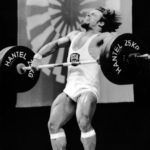
Fred Lowe – An eight-time National Weightlifting Champion and three-time Olympian (1968, 1972 and 1976), Fred was the first American to C&J more than 400lbs. as a middleweight (165 lb.). An eight-time World Masters Champion, Fred has had perhaps the longest career in open national competition is US weightlifting history, having competed in the American Open Championships in 2010 at the age of 63 while having made his debut on the national weightlifting scene in 1966, at the Teenage Nationals. He won his first Senior National Championship in 1969 and his last in, 1981, taking a bronze medal at the Senior Nationals in 1997.
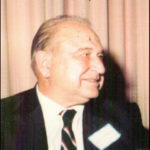
Johnny Mandel – One of the AOBS’s founders, Johnny Mandel served as Chairman of the AOBS for many years, until his death in 2006. A Detective with the NYPD for 20 years, he was the President Emeritus of the Retired Detectives Association and operated one of most successful private investigation companies in the NY area for many years. In addition to his involvement in the Iron Game, Mandel was a top-flight wrestler, who served as the coach of the United States Olympic Team for the 1960 Games in Rome, Italy.
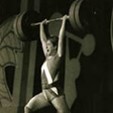
Karyn Marshall – 2015 USAW Hall of Fame inductee Karyn Marshall became interested in athletics at an early age, and in High School excelled in field hockey and basketball, competing in tennis and track as well. She began training for weightlifting in 1978 and participated in her first competition in 1979 (the Empire State Games). She won her bodyweight category at the first Women’s National Championships in 1981. In 1985, she became the first women in history to C&J more than 300 lb. in official competition. Continuing to dominate national competition, she earned a spot on the US team for the first Women’s World Championships, held in Daytona Beach, FL, in 1987. She not only won her bodyweight category (181 ¾ lb.) but she out lifted the heavier lifters in the competition. Since retiring from weightlifting competition, Karyn became a Doctor of Chiropractic and today runs a practice dedicated to helping athletes and others achieve optimal health.
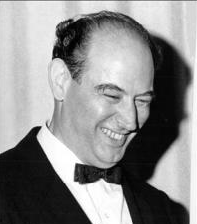
Dave Mayor – Mayor became widely known for developing arms that measured more than 19 inches in the 1930’s, at that time perhaps the largest muscular arms ever developed. He put those arms to good use by earning a spot on the 1936 US Olympic Team in weightlifting and went on to win the US National Championships in weightlifting the following year. Dave later became a professional wrestler and a Regional Director for York Barbell Co. He helped to develop the initial strength training program of the Dallas Cowboys (believed to be one of the earliest ever in professional football) and trained the Vesper Board club for the 1964 Olympic Games.
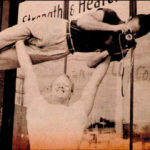
Jim Murray – Jim has been a powerful advocate for weight training for many decades. A lifelong friend of bodybuilding promoter Jim Lorimer (producer of the annual Arnold Sports Festival), the two Jim’s began training together in their early teens, cementing their lifelong commitment to the weights after seeing John Grimek pose in the early 1940s. Jim went on to become a prolific writer on the Iron Game, co-authoring the pioneering “Weight Training in Athletics”. Murray became widely known in the Iron Game when he went to work as the Managing Editor of the Strength & Health magazine, sharing an office with the great John Grimek.
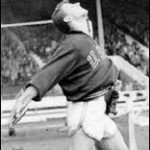
Al Oerter – Having set multiple world records with the discus, Al Oerter was perhaps best known for becoming the first athlete in Olympic history to win 4 gold medals in separate Olympic Games. Although he never entered any Olympic Games as the favorite (there was always someone else who held the world record going into the Games) Al won the discus events at the Olympic Games in 1956, 1960, 1964 and 1968, after which he retired. He made a comeback in 1980 in an effort to earn a spot on the ill-fated US Team that was to boycott the Games in 1980. He continued his training through 1984 and just missed earning a spot on that year’s team. Al always credited weight training as a major factor in his success in athletics.
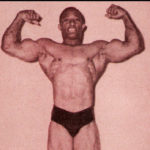
George Paine – Paine was considered by many to be the “uncrowned Mr. America” (many believe a black athlete would simply not be awarded the Mr. America title in his era). After emigrating to the US from his native Cuba, George racked up a slew of victories beginning with the Mr. New York Metropolitan in 1949. He was Mr. NY State in 1950 and Mr. Eastern America, and Jr. Mr. America in 1951. However, at the Mr. America competition later that year, he placed 3rd. He was 3rd again in 1952. Then he placed 4th in 1953 and 1954, while winning the Most Muscular part of the competition in both years. He took second in the Tall division of the NAABA Mr. Universe in 1965 and 1st in that division the following year. George continued to compete through 1978, when he took 6th in the IFBB Mr. International competition at the age of 54!
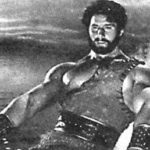
Reg Park – Reg Park first attained bodybuilding fame with a victory at the Mr. Britain competition in 1949. He placed second in the Mr. Universe competition in 1950 and the following year won the NAABA Mr. Universe title. After starting successful publishing and weight training equipment businesses in England, Reg moved to South Africa and opened a gym in 1958. That same year, he returned to the Mr. Universe stage and won a second time. He repeated that trick in 1965, to become the first bodybuilder ever to win 3 such titles. In addition to having a truly Herculean physique, Reg was incredibly strong. He was the second man in the world to bench press 500 lb. officially. His rugged physique and good looks were not overlooked by the film business, which gave him starring roles in 5 movies, built around Hercules or similar legends.
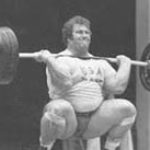
Ken Patera – As a high school athlete Ken Patera played football, wrestled and was a high jumper and hurdler, but he truly excelled in the shot put and discus. He went on to win the Pan American Games in the shot put in 1967. In 1968 Ken decided to focus on the sport of weightlifting, which he had been practicing for years in training. He astounded the weightlifting world by winning the first national championships he entered in 1969 (he would go on to win four in a row). Ken then became the first American to C&J 500 lb. and the only American to press 500 lb. officially. After winning the 1971 Pan American Games, he placed second to the legendary Vasily Alekseyev at the 1971 World. An injury just before the 1972 Olympics dashed his Olympic hopes. He became one of the famous professional wrestlers in the world after retiring from weightlifting in 1972.
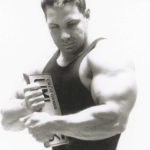
Bill Pearl – Pearl surprised many by winning the Mr. America competition in 1953 but he cemented his bodybuilding reputation by winning the Mr. Universe title and the Mr. USA title in 1956. He appeared in the Mr. Universe competition 3 more times, winning each time (in 1961, 1967 and 1971). Bill ran a very successful gym in Southern California for a number of years, but then turned to writing and publishing. His “Key’s to the Inner Universe”, a massive tome that demonstrated the performance of almost every weight training exercise imaginable with the equipment available at the time, it became an instant classic that was sold to hundreds of thousands of grateful readers over the years. Bill’s subsequent books have also been very successful and his upcoming work on the history of the Iron Game is eagerly awaited by Bill’s fans.
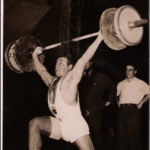
Joe Pitman – Joe had one of the greatest strings of National Weightlifting Championship victories in the history of the United States. Across his tremendous career, Joe won a total of 11 National Championships (the only lifters in US weightlifting history who won more were Tony Terlazzo – 13 and John Davis – 12). Joe was very successful on the international scene as well, winning gold medals at the inaugural Pan American Games in 1951, and then again at the 1955 Pan American Games. At the World Championships, Joe earned silver medals in both 1949 and 1951. Perhaps Joe’s greatest year came in 1950 where, after defeating Tommy Kono and Dave Sheppard in a colossal battle at the US National Championships, he went on to win the Gold Medal at the World Championships in Paris. His total of 352.5 kg. that day equaled to winning totals made by Shams of Egypt the year before and Pete George of the US in 1947. After retiring from weightlifting, Joe made his career as a teacher, educating America’s youth.
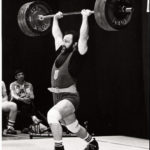
Joe Puleo – Puleo emerged on the weightlifting scene as a teenage phenomenon, breaking “teenage” American and World records. He also won the first of his 5 National Championships in 1962, while he was still a teenager. A year later, he established himself as one of the top lifters in the world, by winning the Pan American Games (which he did again in 1967), along with taking second in the “Little Olympics” (a hastily arranged substitute for the World Championships that had been canceled that year). Joe retired from competition in 1970 to pursue a very successful career as an attorney. However, in 1979, he decided to make a comeback in an effort to earn a spot on the 1980 US Olympic Team. Joe’s effort was successful. He earned that team spot at the 1980 Olympic Trials in Philadelphia. Although the US boycotted the Olympics that year, Joe was invited to compete in substitute championship held in China. By competing in China, Joe became the US athlete with the longest international career in US weightlifting history.
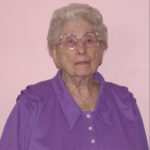
Mabel Rader – Mabel married Peary Rader (see below) early in their careers and became his partner in building the publishing and equipment empires that Peary led. She made her own legend by becoming the first female AAU National Referee of weightlifting and bodybuilding in the history of the US and then becoming a powerful advocate for Women’s weightlifting. She worked tirelessly during the late 1970’s to establish national recognition by the AAU for Women’s Weightlifting. She became Chair of a special Women’s Committee and in 1980 requested that a Women’s National Championship be organized. Her request was approved by the AAU and the first Women’s Nationals in weightlifting was held in 1981. Mabel published the first newsletter for Women’s Weightlifting, which became a beacon for the women’s weightlifting movement worldwide.
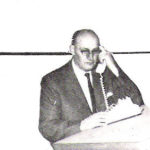
Peary Rader – Peary was for more than 50 years the publisher of Iron Man Magazine (as well as the shorter lived “Lifting News”). Iron Man was revered as an independent voice in the Iron Game. While the incredibly successful publications created by Bob Hoffman and Joe Weider spread the word about weight training throughout the nation and the world, they were perceived by many as close reflections of the views of those men. In contrast, much of Peary’s support came from a broad range independents who sold equipment or supplements and/or wrote for Peary’s publications. Peary’s integrity and independence made him a highly respected name in the Iron Game.
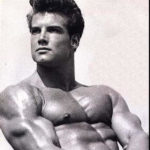
Steve Reeves – Perhaps no name in the history of bodybuilding was more synonymous with the legendary “Hercules” than Steve Reeves. After winning the Mr. America title in 1947, Mr. World in 1948 and Mr. Universe in 1950, Reeves’ classic physique, good looks and drive propelled him to a very successful acting career in the films. While he starred in a number of successful films, Reeves is perhaps best remembered for his depiction of the mythical Hercules in a series of films he made in the 1950’s. Millions who saw his image on the silver screen became imbued with the desire to develop their own physique and strength, so that they could emulate their screen hero.
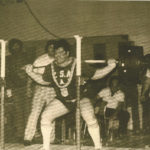
Don Reinhoudt – Don didn’t begin to lift weights until he was 18, and he wasn’t particularly strong when he first touched the iron. During his college years, Don focused primarily on upper body exercises yet gained more than 40 pounds of muscular bodyweight. After graduating from college in 1968, Don entered his first powerlifting competition. By 1972, he had improved enough to place 3 rd in the World Championships, with a total of 2150 lb. He won that championship in 1973 and in the ensuing years added more world championship titles and many world records to his list of accomplishments. Later Don became one of the top performers in the World at the World’s Strongest Man competitions. But Don is perhaps best remembered for the incredible 2420 lb. total he amassed in 1975. It is a total that many believe has never been beaten with the same equipment and rules as the ones that prevailed in Don’s day.
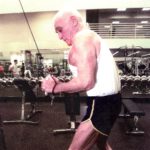
Terry Robinson – A recipient of the AOBS’s highest honor in 1993, former Mr. NY State and Mr. America contender Terry Robinson has earned the title “trainer to the stars” many times over. In addition to his long association with Mario Lanza, as Mario’s trainer and adviser (and the godfather who helped to raise Mario’s children when the star and his wife died within months of each other in their 30s), Terry has worked with the biggest stars in Hollywood for years, from Anthony Hopkins to John Ritter. A writer, artist and true renaissance man, and now more than 90 years of age, Terry is the trainer of the trainers and a manager with Sports Club LA – one of the largest and most prestigious health clubs in the US. Terry has said, “I look at the body as a miracle, and I take care of it by staying healthy and fit.” In the vast list of his accomplishments, Terry is perhaps proudest of his work as a physical therapist, through which he has helped to make the disabled “able-disabled” and the handicapped “handicapable.”
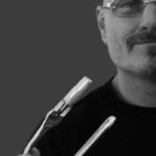
Dennis Rogers – A diminutive weakling as a young boy, Dennis took up weight training and experienced a transformation. His improvements in size and strength led him to explore a wide variety of strength testing feats. He excelled in arm wrestling, winning national and world titles in that sport. He then became interested in old-time strongman feats, encouraged by Vic Boff and Slim “The Hammerman” Farman, he built his strength, along with a portfolio of strength feats, to the point where he has become the most widely viewed strength performer in the world today. When he is not performing, he is helping young people develop their physical strength and character through faith-based and other initiatives that Dennis has dedicated himself to.
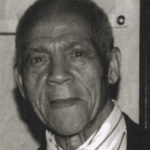
Rudy Sablo – Sablo fell in love with the sport of weightlifting in his teens and soon developed into a national-level competitor. However, Rudy became best known as an official and administrator. In the early 1960’s, he became the Chairman of the AAU National Weightlifting Committee, rewriting the organization’s rulebook and procedures to assure the sport’s smooth administration. He ran the NYC AAU office for more than 20 years, after retiring from the NYC Fire Dept. He served on the USOC Executive Board for many years and was recognized by the USOC, IOC and the IWF for his lifetime contributions to international sport.
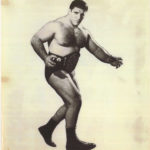
Bruno Sammartino – Bruno was the longest reigning world champion in the history of the World Wide Wrestling Federation. He held the world heavyweight championship during two separate reigns as champion (a total of 11 years). He appeared as a headliner in Madison Square Garden more than 200 times. Bruno received the AOBS’s highest honor in 2000, for his achievements in the wrestling and strength worlds. Besides being a professional wrestler, Bruno, was a strongman capable of world class feats. He has always attributed much of the success he achieved in his fabulous wrestling career to weight training and other forms of exercise. Sammartino grew up in post-WWII Italy, where food was scarce. When he came to the US, he was a sickly and undersized young man. Weight training and healthy living built him into the Hercules who dominated the professional wrestling world for so many years. He is another living example of the power of dedicated training to generate a Herculean transformation.
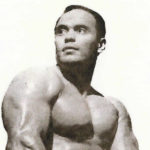
Elmo Santiago – Introduced to weight training by a friend in his Bronx neighborhood, Elmo Santiago soon became a devoted bodybuilder. In 1952, he became Mr. New York Metropolitan. In 1953 he was 2nd in the Mr. North America competition and third in Mr. YMCA. In 1954 he was 2nd in the Mr. Eastern America competition and he won the Mr. New York City title in 1958. In 1959 he won the Jr. Mr. America title and placed 6th in the Mr. America competition. In 1960 he won Mr. North America. The following year he traveled to London and placed third in his class in the NABBA Mr. Universe. In 1965, Elmo returned to London and finally won the NABBA Mr. Universe title.
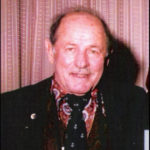
Hy Schaeffer – Dr. Hy Schaeffer was one of the top weightlifters in the United States in the early 1940’s, winning the Jr. Nationals in 1942. Later in his career, he opened a gym in Brooklyn where he was instrumental in developing a number of top lifters, including Olympic Champion and World Record-holder, Isaac Berger. Dr. Schaeffer was also a doctor of chiropractic to whom many athletes turned when they had injuries that were hampering their athletic careers.
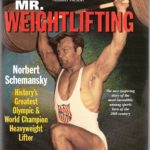
Norb Schemansky – Schemansky is considered one of the all-time greats of weightlifting history. He won the 1946 Jr. Nationals and the following year placed second in the Nationals and then at the 1947 World Championships. He earned a sliver medal at the 1948 Olympic Games. In 1951, Norb won the Nationals for the first time, in the newly created 198 ¾ lb. bodyweight category and then went on to win the World Championships the same year. He earned an Olympic gold in 1952, making world records in the snatch, C&J and total. He won the World’s again in 1953, and moved up to heavyweight in 1954 for still another victory and a new slew of world records. Then Norb twice injured his back and required two major back surgeries that were expected to end his career. But he battled back and won a bronze medal at the 1960 Olympic Games, set world records in 1962 and placed 2nd at the Worlds Championships, after a controversial call by the referees at the Worlds that may have cost him the title. At the 1964 Olympics, at the age of 40, Norb garnered another Olympic medal, becoming the first weightlifter ever to win 4 Olympic medals.
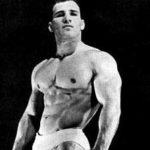
Bill Seno – Bill Seno excelled in powerlifting, bodybuilding and Olympic-style lifting. He won the Mid-Western Section of the Jr. National Weightlifting Championships in 1962. As a bodybuilder, Bill placed 5th in four Mr. America competitions between 1962 and 1973, winning the Most Muscular Man part of that competition on 1964, where he placed 4th overall. He was also a coverman for Health & Strength, Iron Man and Muscular Development magazines. In, powerlifting, he won the first official AAU National Powerlifting Championship in the 198 lb. in 1965. After a period of relative inactivity on the competitive powerlifting stage, he won the 220 lb. bodyweight category at the 1972 Nationals with a record 1805 lb. total. Later that year, he won the 1973 World Powerlifting Championships with a total of 1840 lb. His bench press, deadlift and total were all world records. In 1981, lifting in the 242 lb. bodyweight category, Bill made a lifetime record of 2040 the total. He also bench pressed a record 578 lb.. Many believe that record has never truly been broken by a man of the same bodyweight and same equipment that Bill used (which is to say a T-shirt).
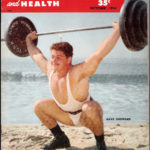
Dave Sheppard – Sheppard earned medals in 4 World Championships and the 1956 Olympic Games, established world records in all of the lifts and was one of the pioneers of the squat style of lifting. At the 1954 World Championships, he was credited by many as having made the most courageous attempt in weightlifting history. Asked to lift in the 90 kg. bodyweight category because the US already had another lifter in the 82.5 kg. category (Tommy Kono) Sheppard’s bodyweight was barely over 82.5 kg. during his competition. In an effort to win, he jumped to 187.5 kg. after his first attempt at 167.5 kg. in the C&J, a weight was 17.5 kg. over the World Record in Dave’s true (82.5 kg.) bodyweight division and heavier than any weight ever attempted by a heavyweight at any prior World Championship. Dave actually shouldered the weight but could not fully rise from the squat position.
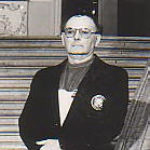
Dick “Smitty” Smith – Smitty made his first trip to York PA in the late 1930s, to purchase a set of weights. It was a journey that was to change his life. During the ensuing years, he began to travel to York with ever greater frequency, eventually relocating there and becoming employed by the York Barbell Co. An astute observer of the Iron Game, Smitty soon began to assist lifters like Bill March and Bob Bednarski in their training and competitions. He could be seen behind the scenes, and in the background on the stage, in nearly any photo of York’s top lifters during the 1960’s, 1970’s and 1980’s. World Champion, Joe Dube, and Olympic silver medallist, Lee James, both give Smitty a great deal of the credit for their international successes. And there are countless others who will always thank Smitty for his coaching on and off the platform. He still trains many people today and conducts tours of the York Barbell Company’s Museum. The museum’s visitors couldn’t hope for a better guide.
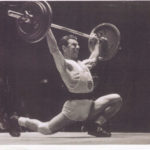
Frank Spellman – At the age of 85, Frank Spellman is the oldest living Olympic Weightlifting Champion in the USA. After becoming a successful weightlifter in the early 1940’s, Frank served for three years in the military in WWII. When he was discharged at the end of 1945, Frank moved to what was then the weightlifting “capital” of the US, York, PA. The following year he won his first National Championship and earned a bronze medal at the first postwar World Championship in Paris. He trained even harder the following year and was rewarded with the silver medal at the 1947 World Championships. He resolved to dedicate himself even further to improving his weightlifting performances and, in 1948, Frank’s persistence paid off. After winning the US National Championship, he won the coveted gold medal at the 1948 Olympic Games in London. He came back to win one more Nationals in 1961. Frank still trains today and is in terrific shape, a shining inspiration to the champions who have followed him.
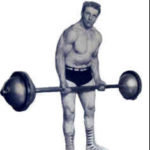
Milo Steinborn – Steinborn became the National Weightlifting Champion of his native Germany in 1920. He is believed to be the first man to officially exceed 500 lb. in the squat. His world record in the squat of 553 lb. lasted for decades. What makes Steinborn’s squatting exploits even more remarkable was that they were performed without a rack. Milo would generally simply load his barbell to the desired weight, stand it on end, tip it onto his shoulders and squat! On the pro wrestling circuit for more than 25 years, Steinborn became a very successful promoter after he retired from the mat. He settled in Orlando, FL, where his Orange St. Gym became a local fixture.
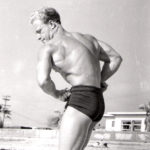
Leo Stern – Stern began his nearly lifelong career in the Iron Game as a weightlifter. However, after seeing the phenomenal physique of the great John Grimek, in the early 1940’s, he developed a passion for bodybuilding as well. After serving as a physical instructor during WWII, he took up serious training again and won the Mr. California title in 1946. He placed 3 rd in the Mr. America competition the same year. Leo is widely known for his physique photos of the great Bill Pearl and countless others (and as Bill’s trainer in his early years). He produced top level weightlifting teams for much of his career as well, including at least one national champion, Bill Lowrance. Leo and his wife Bettye ran very successful health studios for many years.
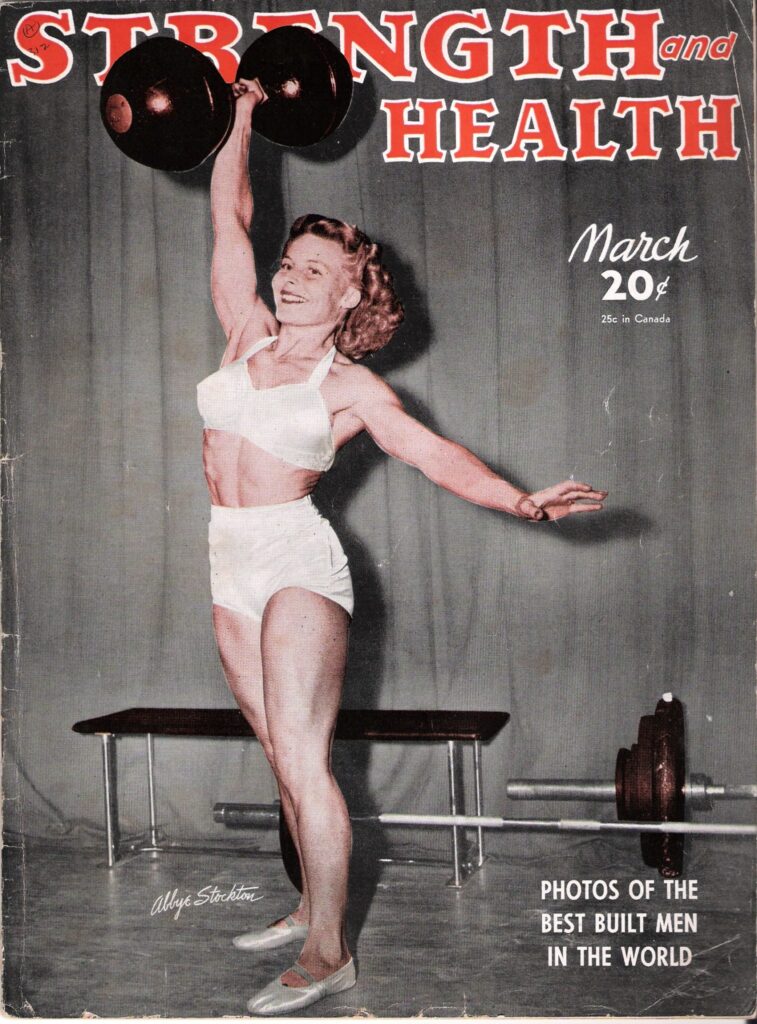
Pudgy Stockton – Abbye Stockton was a dominant figure in women’s physical culture, excelling in the physique world, as a weightlifter, as a gymnast and as an acrobat. Variously referred to as “The First Lady of Iron”, America’s Barbelle” and “The Queen of Muscle Beach”, she could be seen gracing the covers and pages of magazines of physical culture for decades. So amazing was her physique (especially for her era), that a one-piece bathing suit could not be used to display it adequately (her mother made her early two-piece suits). She and husband Les, were among the pioneers who made “Muscle Beach” a legend and organized perhaps the first AAU sanctioned weightlifting competition for women in 1947 (which Pudgy easily won).
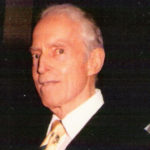
Frank Stranahan – As a teenager, Frank excelled at both golf and football. Frank discovered early on that weight training could help him gain weight and vastly improve his strength. Such training was rare among football players and unheard of for golfers at that time. Although his father tried to talk him out of weight training, Frank persisted and became one of the most outstanding lifters in the US at that time. But golf is where Frank truly achieved amazing results. He won more than 70 amateur championships between 1936 and 1954, including 7 national championships and the 1948 and 1950 British Amateur championships.
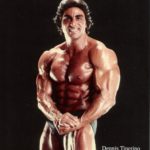
Dennis Tinerino – Tinerino had one of the great physiques of the 1960’s through 1980’s. He won the Jr. Mr. USA and Teenage Mr. America titles in 1965 and Mr. USA in 1966. He won the Jr. and Sr. Mr. America titles in 1967 and the NABBA amateur Mr. Universe title in 1968. He came back to with the Pro Mr. Universe title in 1981. This multi-time coverman for Strength & Health not only had a fabulous physique, but he was an accomplished athlete as well. He had little trouble earning his athletic points for the AAU Mr. American competition, as he became an outstanding Weightlifter after pending only a short time in the sport.
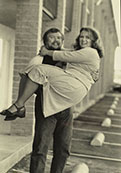
Jan Todd (r.) – One of the pioneers of Women’s Powerlifting, after winning her bodyweight divisions in the first women’s national powerlifting event in 1977 (Joe Zarella’s All American Women’s Open) and the first Women’s World Powerlifting Championship, Jan Todd continued to write the powerlifting record books. Her records included her highest lifts in the heavyweight division of a 545 lb. squat and a 479 lb. deadlift. She and her husband Terry (see below) established the Todd-McLean Library (now the Stark Center), which houses the largest collection of Physical Culture publications in the world.
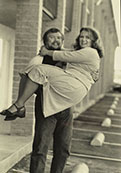
Terry Todd (l.) – Terry Todd began his career as a weightlifter, winning the Jr. Nationals in 1963. Shortly thereafter he devoted his energies to powerlifting and won the first AAU National Championships in Powerlifting in 1965. A former editor for Strength & Health Magazine, Terry authored 5 books in the area of weight training, has been a TV commentator for a wide variety of strength events and has had countless articles published in magazines like Sports Illustrated. He and his wife Jan, developed the largest collection of physical culture publications in the world (see above).
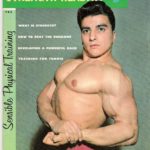
Chuck Vinci– Two-time Olympic champion Chuck Vinci was one of the most successful lifters in US weightlifting history and one of the most hard working. His training endurance was legendary, displayed through such feats as training 8 hours straight, or making a world record in the C&J on his 10th competitive attempt. Across his competitive career, Chuck won 7 National Championships and 2 Pan American Games. He also set multiple world records in the snatch, C&J and total. He had tremendous overall body strength, bench pressing more than 300 lb. at a bodyweight of 123 lb. Chuck was also a phenomenal arm wrestler, able to defeat all the members of the US weightlifting teams of the 1950s, except for some of the heavyweights.
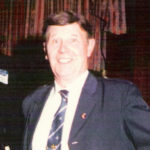
David Webster – Founder of the International Highland Games Federation, Dave Webster has been involved in virtually all facets of the Iron Game for many decades. A prolific author on the history of strength and training methods, Webster has been active as a coach and administrator. He was Director of Weightlifting at he Commonwealth Games (later Chief of Mission for the entire Commonwealth Games). He has been an official for the International Weightlifting Federation and a consultant to the organizers of at least one Olympic Games. In recognition for his lifelong contributions to the sport, Dave was honored with the Order of the British Empire (OBE).
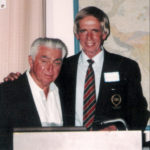
Malcolm Whyatt – Whyatt (r) is known worldwide as a physical culture historian, researcher and writer.He was formerly the publisher of Health & Strength Magazine, the oldest continuously published Iron Game magazine in the world (founded in 1898). Malcolm has also been recognized as a historian for NABBA. Whyatt was an intimate friend of Oscar Heidenstam, Mr. Britain in 1938, Mr. Europe in 1939. Oscar served the NABBA in various posts, including secretary and president between 1956 and his death in 1991, so became one of the most revered administrators in the world. When Oscar died, Malcolm founded the Oscar Heidenstam Foundation in Heidenstam’s honor, with it’s associated Hall of Fame and annual awards dinner (a British counterpart to the AOBS dinner) that attracted the greatest names of the Physical Culture worldwide to its grand evenings, the last of which occurred on March 15th of 2008.
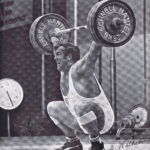
Bruce Wilhelm – Wilhelm has excelled in virtually every strength sport. In wrestling, he was the bronze medalist at the 1965 AAU Nationals in Freestyle Wrestling, and 4th in the Greco Roman Championships the following year. He was ranked in the top 10 in the US in the shot in 1967 and in 1969 through 1973. His personal best with the shot of 66’ ¼”, performed in 1972, still ranked him 251 all-time worldwide in 2009. He won the 1975 and 1976 US Nationals in Olympic-style weightlifting and placed 5th overall at the Olympics, winning a silver medal in the snatch competition of the World Championships held simultaneously with the Games. He went on to become the first American in history to snatch 400 lb. In1977, he won the inaugural World’s Strongest Man competition and he successfully defended his title the following year. Bruce was ABC’s color commentator for weightlifting for Wide World of Sports and became a prolific writer on the Iron Game, having published countless magazine articles and written books on Pat Casey and Ken Patera.
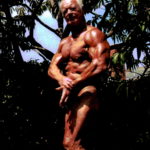
Chet Yorton – Chet discovered weight training after suffering two broken legs and other severe injuries in an automobile accident that he had as a teenager. He went on to win numerous bodybuilding titles, including the prestigious IFBB Mr. America and NABBA Mr. Universe titles in 1966. Always an advocate of natural bodybuilding, he had a successful career as a gym owner, as well as a number of movie roles. Chet pioneered a natural bodybuilding magazine and some of the first natural bodybuilding competitions. He has been “rediscovered” by bodybuilding fans worldwide in recent years, who see him as living proof that a continuous dedication to natural bodybuilding enables one to remain in tremendous condition throughout ones life (as the picture to the right demonstrates – it shows Chet in 2010, at the age of 71! ).
AOBS Memorial Hall of Fame In Alphabetical Order
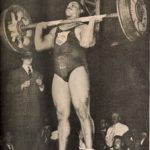
John Davis– John Davis burst upon the International weightlifting scene in 1938, at the age of 17. Appearing at the World Championships in Vienna that year, in the light heavyweight division, Davis became the youngest athlete ever to win a world weightlifting championship. And he broke the world record in the total on the same occasion (amply demonstrating that his victory was no fluke). Thus began in international weightlifting career during which Davis was undefeated internationally for 15 years! Over the course of those years, John won the US Nationals 12 times, set numerous world records, won 6 World Championships and 2 Olympic Games. Considered the World’s Strongest Man in his era, he could have easily defended the title, as he was almost as outstanding in feats of deadlifting, squatting and many other strength tests as he was in performing the classic Olympic-style lifts.
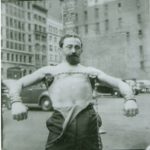
Joe “The Mighty Atom” Greenstein – Though diminutive in size, the Mighty Atom was one of the most famous strongmen of all time. The array of strength feats he could perform was dazzling. And his abilities were not limited to strength feats (the Atom wrestled the legendary George Bothner – undefeated for decades – to a draw). His most famous performance was before a packed Madison Square Garden in 1975 at a Martial arts show. Though past the age of 80, he thrilled the crowd with his mighty feats. Perhaps his most famous feat was biting a nail in half. Joe proved to be an inspiration for many, including Slim “The Hammerman” Farman.
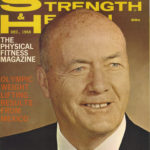
Bob Hoffman – probably did more to popularize the use of weights than any other person in the history of the Iron Game. His York Barbell Co,.Strength & Health magazine and other publications introduced millions to the benefits of weight training, exercise and sound diet. Through his recruiting and coaching he took the US Weightlifting Team from relative minor leaguers in the early 1930’s to legitimate contenders for the World title by the end of the decade and to winning 3 Olympic Team titles after WWII. His tireless advocacy for weight training helped to destroy the myths about the sport and make weight training an accepted conditioning method for athletes in every sport. His marketing of protein supplements was responsible for creating a huge industry. He proclaimed himself the “father of American weightlifting” but it would be hard to imagine anyone who more richly deserved that title.
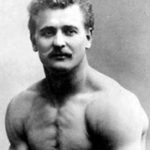
Eugen Sandow – was a phenomenon of his era. Prior to Sandow, there had been many strong men, and strength performers, but he combined his strength and his amazing physique with the ability to display his muscles in an unprecedented way. His reputation grew to sensational levels throughout Europe, where he wowed audiences that included the royalty of the continent. He then appeared in the legendary Ziegfeld Follies, traveling throughout the US and becoming so well known that Thomas Edison made Sandow the star of one of his first short motion pictures. Returning to Europe, Sandow’s fame helped him to successfully establish gymnasiums that were ahead of their time, and training systems that inspired untold numbers to take up and sustain exercise programs for the first time in their lives. Few individuals in Iron Game history had as great an impact as Sandow.
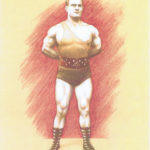
Warren Lincoln Travis – was perhaps America’s first famous strongman. Emerging on the strength scene near the turn of the 20th century, Travis became famous for back lifting and other feats with massive weights that had been made popular by some of the great European strongmen. Based in Brooklyn, he traveled the country, and even outside the US, displaying his strength and challenging all to try to duplicate a combination of ten feats that Travis preferred. He became truly famous after winning jewel encrusted belt offered by the Police Gazette, then the most widely read sporting publication in the US. He died when he was in his 60’s, shortly after performing on on his beloved Brooklyn stage. He mentored another AOBS Hall of Famer, Joe “The Great” Rollino, and is depicted in the Jim Sanders painting displayed on the left.
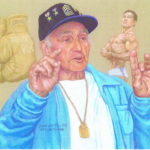
Joe “The Great” Rollino – had perhaps the longest career of any strongman in history. He began training at the age of ten, under the guidance of Warren Lincoln Travis. By the time he was 15, he was performing on stage with Travis, and he continued to perform publicly at least into his 80’s, and informally well into his 90’s. Renowned as much for his character and prodigious memory as for his physical strength, he himself mentored generation after generation of young strongmen, most of whom remained ardent admirers of the great one for the rest of their lives. Boxer, linguist, war hero, bodyguard to the stars, legendary stevedore, cold water swimmer and vegetarian for more than 80 years, Joe left a lasting and positive impact on anyone who had the great fortune to meet this amazing man, who was as enthusiastic about his beloved Iron Game as a centenarian as he was as a young boy.
AOBS Special Guests of Honor In Alphabetical Order
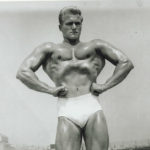
Artie Ehman – To reach a National level in weightlifting and/or bodybuilding requires dedication. Some argue it requires considerable talent as well, arguing that without the right “genes” or other natural advantages, one cannot accomplish such a thing. Well what about an athlete who lacks one, perhaps the most important, of our senses, yet goes on to become a champion in bodybuilding and weightlifting? Well Artie Ehman accomplished that and much, much more across his amazing life, after being blinded by an accident in childhood. This former Mr. New Jersey and Jr. National Weightlifting Championship medallist is living proof that heroes exist and that nothing is impossible to the man (or woman) with an indomitable will.
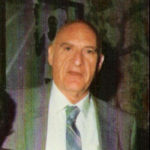
Leo Murdock – Murdock was one of the founders of the AOBS. A lifelong devotee of weight training, Leo was born in Brooklyn. After developing his strength and physique, he relocated to Dallas Texas, where ha had a very successful gym for a number of years. He later returned to NY, where he developed an enormous clientele for the therapy he provided at the famed NY Athletic Club. Leo and Vic Boff worked closely together to develop the AOBS and Leo served as its MC for many years. His daughter, Rosemary Miller, continues to support the AOBS.
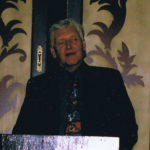
Dave Prowse – Dave took up weight training to overcome illness and disability inflicted on him during his childhood. He developed a phenomenal physique that enabled him to compete with the best in the world in the NABBA Mr. Universe competition, becoming the tallest competitor ever to do so. He then decided to apply the great strength he had developed through his devoted training to the sport of Olympic-style Weightlifting, becoming the British National champion in that sport. He then turned his attention to the field of acting and soon made a wonderful career for himself in that art, ultimately portraying the world renowned villain, Darth Vader, in the first three Star Wars movies. Dave has always been one to use his success as a vehicle to help young people and he has been recognized in his own country and around the world, as a great hero and philanthropist to the young in need.
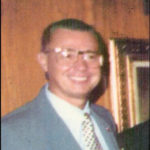
Rudy Riska – A former NY Yankee, Rudy Riska went on to become the long time Athletic Director and event manager at the famed Downtown Athletic Club in NYC. During his tenure with the DAC, he became the Executive Director of The Heisman Memorial Trophy, where he remains the Director Emeritus. He also served as the Executive Director of the National Association of Club Athletic Directors of America. Rudy was instrumental is securing the DAC as the venue for the AOBS annual dinners from 1986 through 1999.
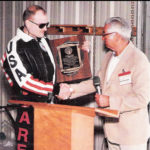
Dennis Rogers (l.) – Dennis Rogers has thrilled audiences worldwide for decades with his fabulous feats of strength. Originally gaining renown as a champion arm wrestler and phenomenal curler, Dennis became intrigued with old-time feats of strength and began to specialize in them, with spectacular results. Vic Boff recognized Dennis on October 10, 1993 with a special award in connection with Dennis’ holding back two planes accelerating in opposite directions. Not only has Dennis excelled in feats of strength, but he is now focused on training and developing a new generation of strongmen ready to carry on the tradition of old-time strongmanism.
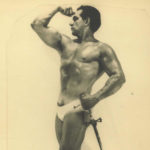
Joe “The Great” Rollino – A true modern marvel, Joe Rollino celebrated his 100th birthday on May 19, 2005. Living beyond the age of 100 is by itself amazing enough, but Joe would be considered vigorous for a man a quarter century younger. His vivid memories of his childhood (he apprenticed with the legendary Warren Lincoln Travis when he was 10 years old), and all the years since make him an unparalleled source of Iron Game (and boxing – another one of his loves) history. Joe became an outstanding strongman in his own right (particularly when you consider his 145lb. bodyweight), having bent coins with is fingers, back lifted more than 3500 lb. and one finger lifted more than 600 lb. In addition to being a strongman, Joe has introduced to, and trained countless numbers of people in the principles of sound diet and exercise. A vegetarian for 80 years, Joe has never drank or smoked, and still exercises daily. He rises every day at 5 AM and goes to bed at 9 PM (regularity being one of his cardinal principles of good health). To say he is an inspiration to all would be a true understatement of major proportions!
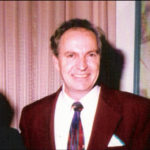
Jim Sanders – Artist extraordinaire, Jim Sanders is widely known for his artistic style and skill – one of his paintings hung in the Bush (II) White House. Jim became interested in the Iron Game at an early age, and trains faithfully until this day. An admirer of bodybuilders, weightlifters and other strength athletes since childhood, he came to the attention of the AOBS when he painted a portrait of the great John Grimek and presented it to him at the AOBS dinner in 1986. Seeing the extraordinary response of Grimek and the audience, Vic Boff asked Jim if he would be willing to create these masterworks for each honoree each year. And he has done so without fail for every AOBS gathering since that time, developing an incredible body of work along the way. Jim has received both Special Guest of Honor awards and Carry On Awards from the AOBS, something he richly deserves. We hope he will continue to grace us with his presence and his artistic skills for many years to come.
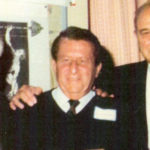
Dr. Theodore Struhl – An active weight trainer for many years, Dr. Struhl also worked with youngsters to teach them the ins and outs of the Iron Game. Many athletes consulted with Dr. Struhl over the years to maintain the capability to compete. Later in his career, Dr. Struhl became well known as an expert witness in many complex court cases.
Carry On and Great Communicator Award Winners In Alphabetical Order
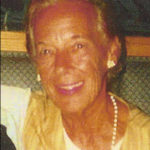
Ann Boff – Ann married Vic Boff in 1943 and was at his side in all the years that followed, working in his health food stores and assisting in his various other enterprises. She served as Vic’s informal editor and advisor during the formative years of the AOBS and continued to support him as he carried on and developed the organization. Upon Vic’s passing, she played a crucial role in guiding the organization’s continued existence, to assure that Vic’s legacy and that of the other AOBS founders continued.
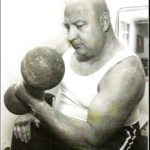
Mike D’Angelo – Mike become active in the Iron Game as a very young man. He trained with many of the best in the Iron Game and developed a deep passion for, and appreciation of, all facets of physical culture. A 500 lb. bench presser at one time, Mike also became a devotee of winter swimming, learning much from Vic Boff and Joe Rollino. When he attended his first AOBS dinner in 1986, he volunteered his skills as a photographer and videographer. Beginning in 1987, he performed those services, and many others for the AOBS, becoming a “right-hand man” for Vic Boff, and later for Artie Drechsler. His service to the AOBS can never be measured.
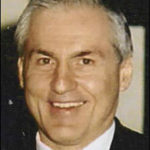
Artie Drechsler – Artie took on the role of President of the AOBS shortly after Vic Boff passed away in late 2002, at the suggestion of Vic himself (that was delivered by Vic’s family and friends after his passing). Author of the “Weightlifting Encyclopedia” and a former junior world record holder in weightlifting, and a Chair of the Board of USA Weightlifting, Artie has worked to continue the traditions of the AOBS, beginning with the 2003 reunion. He received a surprise “Carry On” award from his colleagues in 2007, in recognition of the 5 reunions he had organized since assuming the Presidency at the end of 2002.
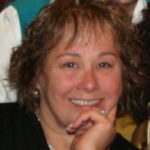
JoAnne Drechsler – When husband Artie Drechsler took on the role of President of the AOBS, JoAnne enthusiastically joined in the effort to keep the AOBS going. Since that time, she has volunteered many hours to administer the annual reunion dinner, greeting guests, providing tickets and rendering many other services to meet the varied requests from our guests. One of the first female national referees in the sport of weightlifting, her father and mother introduced her to the Iron Game when she was a baby and she has probably kept score at more weightlifting events than anyone active . today. She received a surprise “Carry On” award, that her husband did not know about, from her AOBS colleagues in 2009.
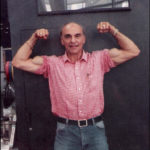
Joe Marino – A Mr. America competitor, Joe Marino became acquainted with Vic Boff when Joe was a young man. When the AOBS was formed, Joe offered to assist Vic and the other founders in whatever ways he could. Vic often relied on Joe to attend to the myriad of activities needed to assure that the annual reunions went smoothly, from picking up an honoree at the airport, to helping Vic find a replacement facility for the Downtown Athletic Club in 2000. Joe was also key in helping to assure the organization kept moving forward upon Vic’s passing.
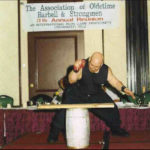
Steve Sadicario – Steve “The Mighty Stefan” Sadicario learned strongmanism from the literal and spiritual descendants of Joe “The Mighty Atom” Greenstein, such as Mike Greenstein (the Atom’s son) and Slim “The Hammerman” Farman, the Atom’s most famous protégé. While he performed at the AOBS reunions, Steve’s enthusiasm and massive voice were quickly noticed. When Vic was looking for an MC more than a decade ago, Steve seemed like a natural for the job, and he was. He has served the organization loyally for many years and continues to perform as well as MC at AOBS events.
Great Communicators
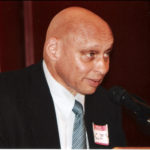
Dr. Ken Rosa – Dr. Ken Rosa is a man of many talents – Dr. of Chiropractic, musician, broadcaster and writer, to mention just a few. His contribution to the AOBS has been long and deep, having served as an MC, and a speaker for a number of honorees. In recent years, he has become our chronicler, regaling readers with his reports of our annual reunions and of other events that he has attended throughout the Iron Game, perhaps most notably the OHF gatherings in England. We thank him for his many contributions and look forward to many more years of the same.
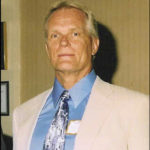
Fred Yale – Fred Yale has been contributing to the Iron Game for decades, as a gym owner, trainer and promoter. He has written extensively on the Iron Game in general and bodybuilding in particular. For more than a decade he has been one of our speakers for AOBS honorees. Our audiences have come to regard hearing from Fred as one of the highlights of our annual gathering. His combination of scholarship and enthusiasm makes for presentations that are spellbinding and we hope he will continue to regale us with his tales of Iron Game legends for many years to come.
Founder Vic Boff
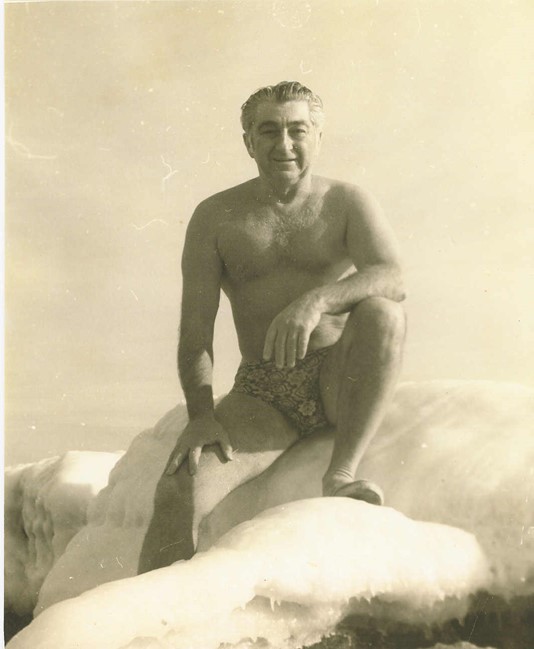
The all-time champion cold weather bather Vic, on Coney Island beach.
Vic Boff – A Wonderful Life
As many of the members of this organization, know, Vic Boff was an amazing man. He touched so many in so many amazing ways that its literally stunning. From small kindnesses, to business rescues to life changing prescriptions of physical and mental cures, Vic’s contributions were all over the map, literally and figuratively.
The following is a brief biographical sketch of Vic’s life. It would take at least a book, and maybe several, to do justice to Vic. And perhaps someday there will be such a book. Until then, here is a summary that will have to do until something more definitive is written.
Vic Boff was born on October 22, 1917, in Red Lion, PA. He was one of two children born to Sam and Rose Boff (the other was his brother Lewis). Sam was the owner of a successful department store chain. Vic’s life might well have been spent in Red Lion and the surrounding areas, perhaps running the family business, had it not been for a major force that swept through country a little more than a decade after Vic’s birth – the Great Depression. During the depression, many businessmen lost their fortunes and Vic’s father was one of them. Seeing his stores close one by one, Sam, decided that the family’s future would be brighter in a larger city. So the Boff family moved to Brooklyn while Vic was still in his teens.
It would be hard to think of a more interesting place for a young man to grow up during that era. Close enough to the center of NYC to be there with a quick subway ride, Brooklyn offered a diversity, a vitality and a semi-suburban atmosphere that provided young people with a uniquely stimulating experience.
A young man of great energy, Vic engaged in many sports and games. When he was between 7 and 8 years of age, he began to exercise on a regular basis, using a variety of calisthenics to build his young body. Later he began to practice extensively on the high bar (in fact, it was while working out on a high bar in Brooklyn that he befriended the great weightlifter, John Davis, as a young man). He also took up weight training, ultimately combining that training with calisthenics, shadow boxing, strong man stunts and year round bathing in the sea, which kept him in wonderful condition throughout his life.
The young Boff developed an affinity for freezing temperatures early on, often venturing out in the most frigid weather with nothing more than a t-shirt, to his mothers great alarm. But this was a habit could not be stopped and, as an adult, Vic never owned an overcoat. By the time of the move to Brooklyn, Vic had developed the habit of sleeping with his window open, even in the deepest of winter. At first his mother worried about his health, but as she grew to realize Vic and the cold were compatible, she simply worried about the rest of the family, so began to put a mat in front of his bedroom door each night, lest Vic’s habits would freeze the rest of the family to death.
By about the time Vic reached his late teens, he had begun to focus most on two sports: boxing and baseball. What could be more appropriate for a lad growing up in Brooklyn? Great fighters and great ballplayers were everywhere. Vic had seen his first major fight at the age of 13, when his father took him to NYC in 1930 to witness the Max Schmeling/Jack Sharkey heavyweight title fight. This experience drove him to begin training in boxing very seriously. With careful boxing training augmented by the strength training and other conditioning work Vic performed, he became very successful as an amateur. After several years on that level, he unexpectedly broke into the professional ranks. While he was working at a resort in upstate NY, he was asked to fill-in at the last minute to fight a professional, whose planned opponent had not appeared. He actually beat the professional fairly handily and thereafter began to fight on semi-professional basis.
With so many interests and a love for a healthy lifestyle, including preventing the destruction of a very exceptional brain, Vic gave up his boxing career by his early 20’s. However, he remained a great fan for many years, being a fixture at the Friday Night fights and Madison Square Garden. Across the years be became friendly with many of the greats of the game, such as Depmsey, Marciano and Robinson, and he witnessed firsthand many of the greatest fights in sports history.
In baseball, Vic enjoyed even greater success. After demonstrating unusual ability on the playgrounds of Brooklyn, he was offered a tryout with the Rochester farm team of the St. Louis Cardinals in 1938. Unfortunately, an injury to his shoulder effectively ended his chance at becoming a major league ballplayer. But as is almost inevitable in life, the closing of one door of opportunity opened another.
In an effort to rehabilitate his shoulder, Vic learned of the reportedly magic healing powers of cold therapy. He had always loved the cold, but on the basis of his continual scanning of the physical culture horizon, he learned about how to use the ice and snow to very successfully rehabilitate his shoulder. He soon became enamored with the idea of cold having more generalized physical benefits than merely rehabilitating an injury. He believed that when the body became accustomed to the cold one’s health would become dramatically improved, often remarking that he’d “seen the weakest become the strongest through winter bathing”. However, he noted that those healthfully stimulated by the cold would turn a bright red while bathing and that “If you turn blue it is not for you” (or at least not until after further training).
Given his love for the cold, cold water bathing was a perfect match for Vic. He joined the Iceberg Athletic (not Polar Bear) Club of Brooklyn in the 1940’s. Part of his initiation required that he carry a block of ice from one breakwater to another on the Coney Island beach. What was typically a major challenge for others proved to be a piece of cake for Vic, with his unique combination of great strength and compatibility with the cold. He became the 3rd President in the Club’s history in the 1970’s and he served in that capacity until his move to Florida in 1992.
I remember Vic telling me that as word of his abilities with regard to withstanding the cold spread, a challenge was issued to him by a winter bather from the Midwest. It seems that this fellow was famous in the Michigan area for his ability to bask in the Great Lakes during the coldest weather. Vic had no interest in “competing” in ice bathing as he simply saw it as a healthful activity. However, he invited the challenger to come to NY to bath with him. The Midwesterner traveled to NY, expecting to return home having established himself as the hardiest of the hardy winter bathers. In commenting on this “match” years later, Vic said in a very matter of fact way, “He had nothing. After 20 minutes they hand to carry him off the beach” (where Vic remained comfortably for a least an hour longer before casually returning to the Iceberg clubhouse). Given his record in ice bathing, it is not surprising that the club members eventually presented Vic with an award for “The World’s Greatest Winter Bather – For His Dedication and Inspiration to Promote Health and Longevity by Winter Bathing”.
Winter bathing always attracted the press looking for what they considered to be a bizarre story. During the NYC blizzard of 1978, one brave reporter requested permission to go with Vic to observe his bathing during the storm (Vic made it a habit to bath every day regardless of the weather). The master ice bather was happy to have someone along and went about his exercise and bathing routine, leaving the reporter/photographer to go about his business of snapping pictures. The reporter appeared to be dressed properly for the occasion, with an overcoat and heavy boots. Nevertheless, after about a ½ hour in the extreme cold, wind and heavy snow of the storm, he nearly collapsed. Vic and helped him back to the clubhouse, where after an hour or so, the reporter had recovered sufficiently to begin his journey back to the office. Vic was glad to help the young man recover, but he regretted losing the time that he could have spent in the snow and water!
During his teens and early 20’s, Vic tried his hand at a wide range of occupations, from writer to stevedore. But the most consistent theme in his life was his growing interest in health. At one point in his evolution, he adopted vegetarianism. In pursuit of his objective of living naturally, he actually moved to a small island off the coast of Cuba in 1940. Then he lived for a year, completely off the land, through farming and other related activities. He enjoyed his life so much that he considered the possibility of remaining in Cuba forever. However, at that point, fate intervened. Word reached him that his mother was gravely ill and he returned to Brooklyn. At almost the same time, WW II broke out and Vic was needed by his country for the war effort. He served in the Coast Guard, where he worked under their Physical Director, his long time hero, former world heavyweight boxing champion, Jack Dempsey.
The return to NY was not without some happy surprises. One day, Vic wandered into the landmark Brownie’s Health Food store in Manhattan. Looking for something healthy to eat, he discovered something(one) completely unexpected – the future Mrs. Boff, then Ann Yunko. Ann was considered by Mr. Brownie to be one of his most promising employees but she was especially helpful to Vic. And soon a relationship between them developed.
While Vic felt an instant and strong attraction to Ann, his wanderlust still burned strongly. So when his tour of duty in the Coast Guard was drew to a close, Boff decided to pursue his physical culture interests in what was the emerging hot spot for such pursuits in the US – Southern California. There he further explored the broad spectrum of natural living, riding his bike everywhere and consuming a quart of carrot juice daily. But soon his love for Ann won out and he decided to return to NYC with great haste. He booked a ticket on the next Greyhound bus headed for NY, even though seating was not assured. He ended up standing much of the way, especially after he got up to give his seat to a mother traveling with a young child who did not have a place to sit (a kindness so characteristic of Vic). But the trip to NY was worth it. He reunited with Ann and they were married at City Hall in 1943.
Ann hailed from a family of Polish coal miners and shortly after she and Vic were married, they ventured to Pennsylvania coal mining country to meet Ann’s family. A rugged, courageous and powerful man in his own right, Ann’s father took and immediate liking to his son-in-law. He became one of Vic’s biggest fans when he saw Boff bend a horseshoe. Vic was equally impressed by his father-in-law’s fearlessness in the woods. Ann’s father dealt with rattlesnakes as if they were gnats and was in total command of the wilds. Vic admired his skill and courage very much.
Back in NY, Vic persisted in his pursuit of wisdom regarding health living. During his younger days, 4th avenue in Manhattan was dotted with dozens of second hand bookstores. Vic haunted those shops searching for books on physical culture, sports and other fields. He spent many hours and dollars assembling a phenomenal collection of books and periodicals. Not only did these resources provide Vic with an incredible breadth and depth of knowledge in the fields of nutrition, natural healing, exercise, strength, bodybuilding and a host of related areas, but his collecting habits made him something of a legend with the booksellers.
On the basis of his reading, and additional training he took in chiropractic and massage, Vic soon built up a substantial practice in Manhattan, as sort of doctor to the stars. In the meantime, he got more serious about his professional writing career (his first magazine article had been published in “Let’s Live” in 1935).
Vic pursued his interest in physical culture with great energy. Realizing that he had a lot he could learn from the greats is the field, he read everything he could find written by the leading writers of the era, such as Bernarr MacFadden and Benedict Lust. He eventually found a way to meet and befriend most of those he admired in the field of health and strength.
For instance, convinced that he could learn a great deal from George Jowett, Vic decided that a meeting with the strongman/publisher/promoter/manufacturer was a must. He learned where Jowett lived and then decided to visit his home without an appointment. When he knocked on the door of the Jowett residence, he was told that Mr. Jowett was not expected to return until the late evening. Since it was a cold winter’s day, the staff at the Jowett home assumed they had seen the last of Mr. Boff, but of course they had no idea what kind of determination Vic had. Unfazed by the cold whether, Vic waited outside Jowett’s home until late into the night. Finally, he saw the figure of a huge man approaching and soon realized it was indeed the legendary strongman. When Jowett reached his home, Vic stepped up and introduced himself. Eyeing the young man with great curiosity, Jowett asked how long he had been waiting. When Vic told him the truth, Jowett invited him into his home immediately and so began a relationship that would last the rest of Jowett’s life.
Boff would go on to write for Jowett’s publications and he and Jowett would become close business associates. Vic contributed to Jowett’s success in many ways, including providing critical assistance during an international law suit that Jowett won and might well have lost without Vic. However, of all the things Vic remembered about his relationship with Jowett, the one of which he was the proudest was his role in reuniting the strongman with Bob Hoffman. The two had been partners during the early days of Strength & Health magazine. A bitter dispute between them soon developed and Hoffman walked away with the magazine in his possession. The two didn’t talk for decades thereafter, but Vic, who knew them both very well, managed to arrange for a reunion, during which these old enemies spent many hours reminiscing. They soon became fast friends again and remained so until Jowett died years later.
While he was in his 20’s, Vic met the famous Joe Bonomo. Bonomo was quite the entrepreneur. He balanced an active film career, a publishing business and a candy company that sold – yes, “Bonomo bars”. Bonomo was perhaps best known for publishing the “little” books on exercise and health that were sold at checkout counters of many stores. Vic became a favorite author of Joe’s, writing many books and often receiving royalty checks on several books at the same time.
In addition, to writing for many magazines, “ghosting” books for others in the field and editing for Healthful Living Publications, Vic wrote several of his own books and did very well with them. “The Bodybuilder’s Bible”, “You Can Be Physically Perfect, Powerfully Strong” and “Molding Mighty Abdominals” were among them.
As a young man, Vic met Bob Hoffman. Early in his relationship with Bob, Vic provided assistance with a legal matter in NY. Hoffman offered Boff a “Big 12” barbell/dumbbell set as repayment for his services. Vic felt a little disappointed with the offer and decided to ask for a much more valuable Olympic set. Hoffman was surprised by this response, but he respected Vic’s pluck and this episode soon led to Bob’s calling him the “big businessman from Red Lion” (who had talked his way into an Olympic set).
Vic represented York in a variety of ways in NY and elsewhere over the years, and he became Bob’s eyes and ears in the community, often relaying critical information to Bob regarding the reception that his products were receiving. In at least one instance, information from Vic’s vast network of associates may have literally saved the scope of Bob’s Company.
It seems that Vic had gotten word that some members of the medical community were lobbying the YMCA’s to throw weightlifting out of their facilities across the country. At the time, Y’s were perhaps the major institutional venue in which weight training occurred across the US. Virtually every Y had some weightlifting equipment and in future years, Y’s were to become the training quarters for many of the greatest weightlifters in US history, not to mention hundreds of thousands of athletes in all kinds of sports.
As soon as Vic heard about the Y’s plan, he contacted Bob Hoffman and suggested that Hoffman and some of his top lifters attend a meeting where this issue weight training in the Y’s was to be discussed. Hoffman recognized the urgency and importance of Vic’s request and brought his top team members, Grimek, Stanko, Stancyzk, Terlazzo and Terpak to the meeting. He spoke about the benefits of weightlifting, exploded a number of myths and then asked John Grimek pose. Grimek’s size, lean body mass and symmetry were astounding for his day (and for very long thereafter) so the physicians and others in attendance assumed that he was a classic example of a “musclebound” person as soon as they saw him. But when John moved into a full split, touched his elbows to the ground with his legs straight and clasped his hands behind his back (one coming from over the shoulder and the other around the back) the audience was literally stunned. Few if any had ever seen someone so flexible and the fact that Grimek could do these things while being so muscular completely blew away any notion that “weightlifters” were musclebound.
Hoffman culminated the demonstration with a challenge. The Y could pick its top 5 athletes who did not train with weights and they could each select 5 sports in which to compete against Bob’s team (but they were precluded from choosing their own sport). Similarly, Hoffman’s lifters could choose 5 sports, but not weightlifting. He offered $5,000 (the equivalent of hundreds of thousands of dollars today) if the Y’s team could beat his. There were no takers. In fact, to his credit, the physician who had intended to put weightlifting out of the Y’s, became an advocate of weight training.
So the battle for weightlifting’s acceptance was won (at least for many decades). The weightlifters were allowed to remain and Y’s weightlifting programs throughout the country flourished. Partly because of the behind the scenes work by a man named Boff.
Vic was a man of many careers, but his longest-lived single business enterprises were his health food stores. The first one opened in the 1950’s on 101st Street and Amsterdam Avenue in Manhattan. A few years later, his store moved downtown and few blocks and over to Broadway, where it remained until Vic closed it in the 1970’s. A second store, Vic Boff’s Healh and Fitness Aids, was opened on 86th Street and Bay Parkway in Brooklyn, while the Manhattan store was still in operation. The health food stores were a perfect match for Vic. They gave him a base of operations at which he would be visited by a vast number of those in the Iron Game. They also provided him with a “bully pulpit’ from which to deliver his message of physical culture in all of its varieties.
But the venture into health food business wasn’t without its challenges. For instance, on the eve of the opening of Vic’s first store in Manhattan, disaster struck. Steam pipes near the store burst and Victor’s entire stock was ruined by the heat and moisture. Many businesses would have been crushed by that kind of tragedy at such a crucial moment. But when Vic called all of his vendors to see if he could replace the damaged goods, though his credit had been stretched to the limit when he stocked the store initially, he found that his reputation for honesty was so strong that every vendor agreed to replenish his stock on the strength of his word alone. Hence the store was saved and went on to be a great success.
In 1992, Vic made the decision to sell his health food store in Brooklyn (to a couple who had worked with him in that store for many years) and he and Ann moved to Cape Coral, Florida. While retired from his own business, Vic devoted countless hours to supporting others. He consulted with Tom Lincir, founder of Ivanko Barbell Company for many years. He counseled Tom Ciola of “Hot Stuff” fame. Both of these men give Vic great credit for the tremendous success that their businesses have had, as do many others in the Iron Game. There are countless others who Vic helped as well, on a very personal level. Those stories are too numerous and too personal to tell here, but they demonstrate that Vic could never ignore someone in need of help.
Renowned for his encyclopedic memory regarding the Iron Game, Vic was consulted by anyone interested in Iron Game history when they had a question. He often knew the historic figure you where interested in, or at least saw him/her perform great feats. And if he didn’t have firsthand knowledge, he knew the answer on the basis of what he’d learned from others, or the vast reading he had done. However, his knowledge was hardly restricted to the Iron Game, or to the realm of physical culture.
Joe Marino tells a story about one of Vic’s recent visits to New York, when he was well into his 80’s. Joe and Vic were concluding a meal at the renowned Wally & Joseph’s restaurant in NY (Joe’s and Vic’s favorite) when a sports reporter from the NY Times happened to be seated next to Vic and Joe. A brief conversation ensued and when the reporter learned a little about Vic’s history, he began to question Vic regarding sports trivia. He soon found that there was not a single question he could pose in the areas of boxing or baseball that Vic could not answer. Moreover, Vic posed several questions to the reporter that the reporter could not answer. By the end of the evening, Vic had supplied the reporter with valuable information for forthcoming columns and the reporter had become one of Boff’s newest admirers.
Vic always counted meeting Joe Greenstein (the Might Atom) as one of his most tremendous experiences of his life. “Here he was, a man who only stood 5’5”, 140 pounds, who could perform feats of strength (such as bending iron spikes, breaking chains across his chest, pulling cars or airplanes with this hair) that would put the biggest men to shame. He had no equal.”
Another legend of the Iron Game who Vic admired greatly was Sig Klein. Klein had his doubts about Vic’s abilities when he first met him (as Sig did about all newcomers), but after watching Vic perform some strength feats, he quickly accepted him as the real article and they soon formed a strong friendship. Over time, Vic grew so close to Sig that on the occasion of Sig’s 81st birthday, in 1983, Vic organized a birthday celebration in Klein’s honor. A modest celebration with perhaps a little more than 50 in attendance took place at Lenny’s Clam Bar in Queens, NY. Once word got out that the party had occurred, many of Vic’s associates expressed their desire to attend if there was ever another such event. So Vic decided to organize another party the following year and by that time the size of the group had nearly doubled. The location of the dinner was moved to Wally & Joseph’s restaurant in Manhattan, where it was held for 2 consecutive years. By that time, the gathering had grown once again and Vic began to realize he was on to something very big and important.
Strongmen the world over wanted and needed an annual celebration of their field, a forum to honor the past, renew acquaintances and meet the greats of the Iron Game. So in 1986, with the help of his friends Johnny Mandel and Rudy Riska, Vic moved to dinner (which had outgrown a restaurant setting) to the famous Downtown Athletic Club, home of the legendary Heisman trophy. That year, the dinner evolved from a birthday party to a celebration of the Iron Game and, most appropriately, the first honoree was the “Monarch of Muscledom” himself, John Grimek. This time there were a couple hundred guests in attendance, among them some of the most famous men and women in Iron Game history. It was a fabulous evening for all in attendance (I was lucky enough to have been one of them). The outpouring of support for John Grimek was incredible. I doubt even he realized how many lives he had touched and in how many ways. After such a glorious evening, Vic was sure he was on the right track with his organization, which he was to continue to nurture and grow for the rest of his days.
Those who were close to Vic know how much his wife Ann supported him in all that he accomplished over the years. In addition to raising the family and often managing the health food store for Vic, she was also his part-time editor and confidant in many other areas – including the aforementioned nurturing of the AOBS. And she has been of great support is helping the AOBS in continuing on.
Those who know Ann will testify to her mettle. Once, while she was tending to the health food store, a would-be robber entered. Vic was working in the back. The man demanded the money from the cash register. At first Ann called for Vic, but when it became apparent that Vic did not hear her calls for help, she became so annoyed with the situation that she confronted the robber and chased him out of the store with the steel rod that was used to lower the store’s awning! Vic could only laugh when he heard the story.
Vic is also survived by his two sons. Dr. Kenneth Boff is a renowned psychologist who runs a major division that studies human performance for NASA and the US Air Force. George Boff has had a very successful career in the health food business for many years.
There are also 4 Boff grandchildren: Ken’s son and daughter, Cory and Kyra, and George’s daughters, Amanda and Andrea.
Vic Boff’s life created an amazing legacy. It was a life full of excitement, of adventure, of a profound commitment to values, of helping others and of the sheer joy of camaraderie with those of like values. His story is indeed the story of a wonderful life. But it is also the story of a man who made the lives of so many others more wonderful merely by offering them the priceless gift of his friendship. Thank you Vic, from all of us!
